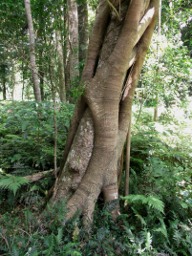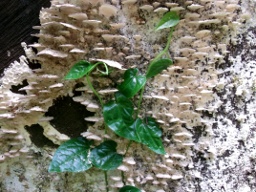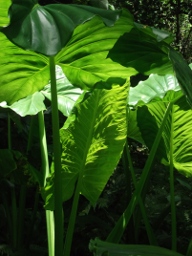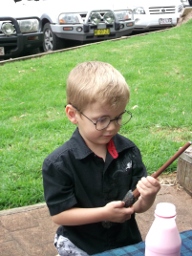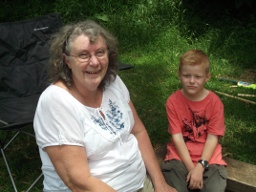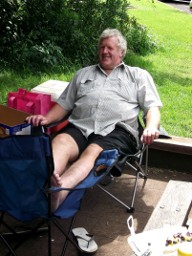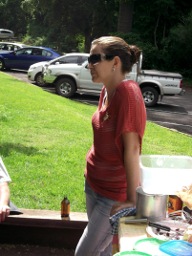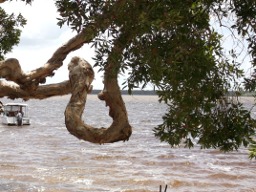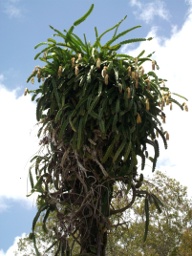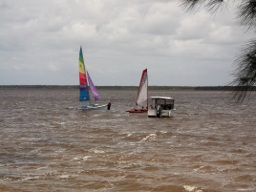Victoria and Queensland, November 2011 - January 2012
Introduction
I made a research visit to Monash University in Melbourne, supported by
Graham Farr's ARC Discovery grant to work on algebraic properties of
chromatic roots, and also including the 35th Australasian Conference on
Combinatorial Mathematics and Combinatorial Computing, organised by Ian
Wanless and also in Monash.
Monday 28 November
I'm starting this diary the day before I leave because of what happened this
dreadful day.
Our Windows laptop having caught a virus and been essentially ruined by the
incompetence of PC World, my Asus eee-pc having several keys and mouse
button wearing out, and the wi-fi on the psiXpda not working, I decided it was
time for a new computer. Also, since the distant focus on my camera is
increasingly dodgy, I ordered a new camera at the same time, a cheap Fuji (the
brand I used when I was much younger). The parcel was sent via a delivery
company rather than the post, and they were supposed to deliver it
on Saturday, but inevitably they didn't come. So I got up early, walked to
Whitechapel, took the Overground to Surrey Quays, and walked 25 minutes to
the delivery company's depot, just off the Old Kent Road. (Whitechapel Road
to Old Kent Road in three-quarters of an hour).
Disaster struck as I turned off the Old Kent Road into the little lane where
the depot was. Paying more attention to looking for the address than to my
feet, I put a foot into a loop of the tough plastic "wire" which is used
to fasten notices to lamp-posts. It seemed to be stuck to the ground in
some way. Anyway, my foot went into the noose, and down I went.
For the best part of a minute I was unable to move: first from shock, and
then because of a deep pain and immobility in my right shoulder. My glasses
fell onto the road but fortunately were undamaged. After a while, I was able
to turn over in a slow and painful way, and push myself up with my left arm
(fortunately undamaged). As I got up, I felt my right shoulder click back
in; it seems it had been dislocated but had fixed itself. Still painful,
though.
I found the place; I have never before seen such a concentration of unmarked
white vans, as the drivers (all black men) queued up to get their deliveries.
I found someone who went away and fetched the parcel. Fortunately it fitted
in the shoulder bag I'd brought, and this went on my left shoulder, and so
I struggled back to Surrey Quays. Touching my card on the reader was a bit
of a problem: I had to use my left hand to extract it from my shirt pocket
on my left side, then reach across to touch the reader.
The train when it came was more crowded than I have ever seen a commuter
train, anywhere. At least the press of people stopped me from falling over.
At Canada Water, fortunately, a few people got out and we could breathe again.
I got the train back to Whitechapel and walked home.
I was back soon after 9am, and Rosemary hadn't left for Cambridge. So I had
a bath (getting out was difficult), and she made me some breakfast, and then
I went to work. There was a difficult personnel matter which took
up some time, but despite that and the pain in my shoulder, I managed to
connect the new laptop to the College wi-fi, and download the Gimp, LaTeX,
GAP, and emacs. (There is still a problem with GAP which I haven't
resolved: it can't find its packages).
With all of this, I didn't get any lunch. Since I was running down food in
the house before my trip, I stopped at the Co-op and got enough to serve
for both late lunch and dinner (but just stuff that could be eaten without
preparation). To bed not too late, and by dint of being very careful where
I put my right arm, I managed to sleep tolerably well.
Tuesday 29 November
|
I am working with Celia Glass and Robert Schumacher on acyclic orientations
of graphs. Today was our last meeting before the trip, so I walked over to the
Cass Business School via Whitechapel, Brick Lane, Liverpool Street, Old
Street, and Bunhill Fields. I took the new camera, and
decided to try it out in the very photogenic Bunhill Fields (the old
nonconformist burial ground where people such as William Blake, Susannah Wesley,
Daniel Defoe, and Thomas Bayes lie). Apart from the fact that it was set to
red-eye reduction rather than no flash, and I couldn't figure out how to
change this setting, it seemed OK.
|
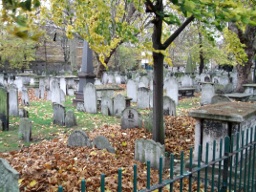
|
We had a good session, talking about where we are going, and what we hope
to achieve before we resume our meetings in January. Robert came at 11 as
usual, and told us about what he had been up to. He has done a much more
extensive sample of random graphs with 8 vertices and 15 edges. The
distribution he gets, even with 10000 graphs, has a lot of holes and spikes,
but he says it passes a statistical test for a normal distribution with
flying colours. Then we talked about his attempt to determine the graphs
with the maximum number of acyclic orientations. A certain step in his
proof doesn't work, but we made some suggestions about how this might be
fixed. (Curiously, the graph with 8 vertices and 15 edges with the maximum
number of acyclic orientations is the complete bipartite graph on 4+4 minus
an edge; my PhD student Aylin Cakiroglu has just shown that this beats the
complete bipartite graph on 3+5 vertices on various statistical
optimality criteria.)
Then I walked back, to an unusually busy afternoon. First Max Gadouleau, for
our last session ever, as he will be in Durham by the time I get back: he is
currently a postdoc in computer science, but has landed a lecturing job in
Durham. We have been talking about the notion of "memoryless computation"
which he and his boss Søren Riis have developed, and in particular,
memoryless
computation in permutation groups. He has got Ben Fairbairn from Birkbeck
interested in the problem, so he brought Ben along as well,
and we had a good session, proving something about dihedral groups.
I downloaded the improved version of the vi editor onto my new laptop (which
was easy) and tried to fix the GAP problem by getting the GAP packages via the
ubuntu installer (which didn't work; you have to know what the thing you are
after is called). I also needed to print my boarding card, and find out how
to turn off the sound effects on the camera; I succeeded in both of these.
Aylin came, and I sent her off with some suggestions about what she might
do next. On the basis of the coincidence with Rob's work, I suggested looking
at whether Turán graphs are optimal, or close to it. These graphs are
quite dense, and may not have been covered in the literature.
In the middle of this busy afternoon, some extra business cropped up,
and took a chunk of time.
I once again had missed lunch, and had to get lunch and supper at the Co-op
on the way home.
I have decided on the high-risk strategy of taking with me only the new
computer and camera, and hoping that they don't let me down.
After finishing my packing and throwing out the kitchen scraps, I decided to
leave good and early for the airport. I had to carry both bags in my left
hand; but I had packed light enough that I could manage this. At the airport,
the bag drop was quick, and I found myself with a bit of time on my hands.
I had got both a Guardian and an Evening Standard, so I did most of the
puzzles. Curiously, one of the answers in the Guardian quick crossword was
"Rosemary", and the final word to be found in the codeword in the Standard
(theme: boys' names) was Cameron. The cryptic crossword in the Guardian was
by Araucaria (my favourite compiler), so I saved that for the plane.
I had been a bit gobsmacked when I printed out my boarding pass to see that
I was in seat 88F. The plane was an Airbus A380, one of these monstrous
planes with a seating capacity of 450. I was in the very back row, right in
the middle, for the entire journey to Melbourne.
We left just a little late, and by the time they had served the dinner it
was midnight London time.
Wednesday 30 November
So I spent almost the entire public sector workers' strike day in a plane or
at airports.
When it turned midnight, I advanced my watch to Singapore time (already 8am),
and then had a bit of a sleep. But I wanted to have my eyes open during the
day, long before it suited the airline's schedule. The best I could do in
my poky little seat was to put the light on. I had already got a couple of
clues in the "monkey puzzle", but spent the strike day getting almost all the
rest of the puzzle out. It turned out that a "recent event" cross-referenced
in a couple of clues was the Rugby World Cup. Another answer is, I think,
the name of a star player in this event, so I haven't been able to do this
one.
I also watched the flight path, and the outside camera. In this plane the
camera is mounted in the tail, so the fuselage and wings of the plane are
always in the middle of the picture. It also means that, no matter how the
plane shakes, the image of the plane is rock steady (even though the
horizon may not be).
Just before we got to Singapore, the flight path data went haywire. They
kept making the arrival time later and later, by substantial amounts (over
an hour and a half, in total). It wasn't even consistent; the time to
destination, distance to destination, and speed did not satisfy the obvious
equation. (I think there was more than one error.)
We landed in Singapore a little after 6 in the evening; it was already dark
outside. We were kicked off the plane (a slow process) and made to go through
a security check to get back into the departure lounge (a remarkably quick
process, though they were much more thorough than the people in London,
even though not so obviously rule-bound). Between going out and coming back in,
I threw away some rubbish; when I got back on the plane, I couldn't find
the "monkey puzzle", and thought that had gone too.
Food was a little slower coming this time, but eventually I was able to get
a bit of a nap.
Victoria
Thursday 1 December
I watched the approach to Melbourne on the outside camera, as the sky went
from uniform black (even on the highest contrast) to a band of red, to an
arch of brightness, and finally the sun dead ahead. There were a couple of
interesting illusions, presumably just lens flare. A golden man sat on
the fuselage, like a bright angel coming along for the ride. When we
shifted course a bit, he jumped down onto the wing, and grew a couple of
wings of his own. Then, when we turned a bit more, he flew away. Later,
a couple of flying saucers escorted us to the airport. One at least tried
its best to prove that it wasn't an illusion by disappearing when it went
behind a small wisp of cloud. (Really, of course, the whole scene was an
illusion.)
On this huge plane, there were sufficient cabin staff that there was no great
delay in serving meals or bringing drinks and "refresh packs"; but the
effect was really noticeable on landing. It took us twice as long to get
off the plane, and then twice as long for the bags to come. Eventually mine
did come, and I got out of the airport without further trouble.
While getting my waistcoat out of my hand luggage (Melbourne is warmer than
London at the moment, but still cool enough that I felt the need of another
layer), I found that I hadn't after all lost the monkey puzzle. The clue to
which the answer is "Rugby World Cup" is:
"Warmer student in perfect example caught up in recent event".
Another, simple but very elegant, clue, is
"Tell us, with skill, where you live (7)"
(a triple meaning).
Graham had said he would meet me, in case I was unable to carry my bag. I
walked around the terminal looking for him, and was just about to head to
a coffee shop when he turned up. We took a taxi to the university. It's
quite a long way, since the university and airport are on opposite sides
of the city; but eventually we were there.
I had another problem by this time. I had noticed in Singapore that I had
a pain in my left foot, causing me to limp a bit. I had taken my shoes off
for the flight; putting them on seemed to cause the trouble. It got worse,
and I was now hobbling noticeably.
As always, what a pleasure being back in Australia! Blue sky, eucalyptus
trees everywhere, a sparkle in the air which I don't find anywhere else.
Two observations I made on campus. The commonest birds are mickey birds
(this is what I called them when I was a child; officially they are noisy
miners),
which are much bigger than Queensland mickey birds. (I think there is a law
in biology that members of a species grow larger further from the equator.)
Also, when something orange-brown swirls past, it is not autumn leaves, as it
would be in London at the moment, but huge
butterflies. Other birds on the campus include magpies and galahs.
|
We went to Mannix College, where I will be staying. Despite the early hour,
there was somebody there, and I was able to check in and go to my room.
I had a shower and changed, and headed for the IT department (Graham had
given me clear directions). There I found Kerry McManus, from whom I
got a key to an office, with a computer (but no username or password) and
no black or white board. The contents of the office suggest that it was
recently occupied by an administrator rather than an academic.
(When I got logged on, there indeed were emails from the system managers
giving me this information, sent yesterday while I was somewhere up in the
air. I remember a Readers Digest story from my
youth about someone in a newly-independent British colony who requested
a post-office box. Hearing nothing for six months, he checked up. Oh yes,
he was told, we allocated you a box, and sent you a letter telling you
of this. You can imagine where the letter was.)
|
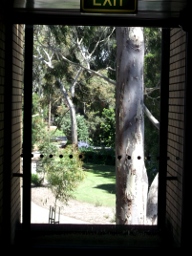
|
Graham had told me that Daniel Horsley would be talking at 10, so I went
to that. He, Darren Bryant, and a PhD student, have proved a conjecture
of Brian Alspach. You want to partition the edges of the complete graph on
n vertices into cycles of prescribed lengths. The obvious necessary
conditions (the cycle lengths lie between 3 and n, their sum is
n choose 2, and n is odd)
are sufficient. But they don't really want to claim it since it is not yet
written up. Nice talk.
Many people were pleased to see me, but I had to warn them not to shake my
hand.
Afterwards we had coffee (and scones with cream and jam, left over from
an event for the tutors) and talked for a while. Then Graham came to help
me sort out the computers.
This got at least the wi-fi working, so I could use my new laptop; the
desktop was more recalcitrant.
Then Graham and I went to lunch. (I could have eaten at the college, as
part of my board, but had missed it by this time.) We had a long talk,
finding ourselves in agreement on a range of things.
After lunch, Graham persuaded an IT person to come over, and finally I
could log in to the desktop machine, but (unlike the wi-fi) not into the
University network, only into that computer; but from there I can reach
my account at Queen Mary by ssh, and of course the web browser also works.
Graham and Keith Edwards (who is also here) had to go mid-afternoon, so I
stayed for a while, and then went home via the chemist, where I bought some
shampoo. (The college only provides soap.) I asked him about my foot; he
said it was likely to be excess fluid; rather than rubbing in
anti-inflammatory cream, I should just rest with my feet up!
I went to dinner in the College. There were fewer than ten people eating.
Keith was there, talking to someone who may be the chaplain, so I joined
them, and we had an enjoyable chat over a typical institutional dinner:
curry and rice and/or pumpkin pasta, with veggies (carrots and beans).
This is a Catholic college, named after Archbishop Mannix. I had heard
of him when I was a student, but didn't know all the things I have just read
in Wikipedia: he was archbishop of Melbourne for 46 years, opposed conscription
(which the Labour government wanted to introduce in World War I), opposed the
White Australia policy, ...
After dinner, it was still bright day, so I postponed going to bed for a
while, and wrote up today's diary.
Friday 2 December
During the night the pain in my foot became much worse. I decided I'd have
to get medical advice. I should set down all the relevant information.
It didn't start until the flight from London to Singapore. There could not
have been any pain before then since I was forced to put all the weight of
my bags on the left side and would certainly have noticed it. On the plane
I was aware that all was not right with my foot, and kept moving it around,
but space was severely limited. It was when I put on my shoes to disembark
in Singapore that I really noticed something was wrong. Yesterday I was
hobbling a bit, but apart from the fact that I had to cross the wide road
between the college and the campus in two goes I was not inconvenienced by
it, and it was not very painful. But in the night I found it couldn't put
weight on it without severe pain, and getting even the short distance to
the bathroom was very difficult. The pain is there, but not bad, all the
time, but pushing off from the ball of the foot is what really hurts.
When I decided I was awake, and the birds had begun to sing, I got up and
soaked a teatowel in water and wrapped it up. It now felt as if cold is
what it needed.
I read more carefully the Wikipedia article about Archbishop Mannix. What
I remember from school is that non-Catholics resented him because he told
Catholics how to vote, and so held a lot of political power de facto.
But his story makes it absolutely clear that nobody told him how to vote or
think about anything whatsoever.
|
By breakfast time, my foot was considerably improved, and I could walk
almost normally. I found Keith and the chaplain at breakfast, with an
American who is at an artificial intelligence conference this week.
After breakfast, I met the woman who cleans the rooms on this very long
corridor (I am her only client at the moment), and had a brief chat. A bit
later, she arrived at the door bearing an icepack. So I sat and worked for
a bit with the icepack on my foot.
I ventured out, across the busy road to the campus (something I would have
thought of as impossible during the night), and didn't even stop at the
medical centre, though I did enquire at the pharmacy about emu oil (they
don't have it). In the department, Kerri Morgan (whose office is just down the
corridor) suggested a trip to a huge discount
chemist, which would be likely to have it if anyone does.
|
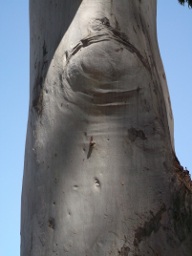
|
We drove there, and walked up and down the vast aisles: the place was like
a slightly dingy warehouse. No emu oil among the alternative medicines; none
among the skin care or deep heat clones; eventually we found it (I don't
remember what its neighbours were). They had tea tree oil as well, so I got
some of that too.
I'd mentioned that I couldn't find a decent hat when I was packing, and so
Kerri suggested going on to Target, which is in an absolutely vast shopping
centre. Clearly big enough not to be crowded, and we got a park near to the
right bit, so not too traumatic at all! I got a hat (the only cloth hat with
a string they had in stock), a pair of shorts, some batteries, and some
chocolates for tonight.
Back to the department, I rubbed emu oil into my foot (the priority) and a
bit into my shoulder. Then it was almost lunchtime so I headed back to
Mannix, managing to cross the wide road on a single change of the lights.
The food isn't great; lunch was not appetising to look at. They had pies,
made of very thick and very hard pastry, some smaller pastry items, and chips.
Fortunately there was salad to eke it out.
In the afternoon, Graham, Kerri and I finally managed to get together for
a mathematical chat. We decided to step back from the detail a bit. Kerri's
thesis has a lot about "chromatic equivalence" of graphs, i.e. having the
same chromatic polynomial, and finding certificates for this. She also
looked at graphs where the chromatic polynomials have the same Galois group,
or the same discriminant. But the "right" thing to look at is clearly having
the same splitting field, which implies same Galois group and is implied by
same chromatic polynomial. We looked at the graphs with at most nine vertices
with Galois group C4, listed in Kerri's thesis, and found
that they fall
into just three "splitting field equivalence" classes. It turns out that
Maple is brilliant for this. It can find, in the blink of an eye, the
factorisation of one polynomial over the algebraic number field generated
by the roots of another.
At night we had been invited to Graham's house for dinner. Graham and
Keith were going to take the bus, and Kerri to drive me, but since that
meant her husband David would go in an otherwise empty car, she asked him
to come and take some of us, making for a much more comfortable trip.
We had a lovely evening. Graham has a two-year-old daughter Geneveive,
who arrived unexpectedly (the second youngest of his children is already at
high school) but is very appealing, though a bit shy with strangers. People
came and went, we tucked in and then
talked for longer than we had planned. Keith, also a bit jet-lagged, wilted
first, and we got home at about 10. He and Graham are off on a birdwatching
trip tomorrow; I certainly didn't offer to accompany them!
Saturday 3 December
I slept soundly, waking once (so far out of it that it took me a good
minute to remember where I was, and then walking to the bathroom as if
I didn't have a bad foot), and then woke for good fairly early; breakfast
is later at weekends.
Graham had lent me a one-cup cafetière and given me a packet of coffee,
so I am no longer at the mercy of the machine-made Nescafé in the
college dining-room. So I made a cup, and worked for a while. Then I had a
shower. The water is good and hot, though the adjustment of temperature is very
delicate! After drying myself with a little difficulty, I oiled my shoulder
and foot with emu, and went down to breakfast.
It is strange that my foot, which only the night before last was driving
me to despair, is virtually completely healed, whereas the shoulder is not.
I have regained full use of my hand, but mobility of the shoulder is still
not back to normal; I can only lift my arm above shoulder height with great
difficulty and some discomfort. I do this a couple of times a day just to
keep the muscles stretched.
Today is cloudy and quite a bit cooler than yesterday.
After breakfast, with a leisurely morning in prospect, I did my laundry (not
a huge amount yet but better do it now while the college is empty), read,
and worked a bit. I had change for the washer but not the dryer; fortunately
there were some people in the lobby and one could give me a dollar in
exchange for some loose change.
I made another attempt to install GAP, with no better success than before.
But I did make a bit of progress with the new machine. I read up on
Wikipedia about Gnome. It seems that there was a big change in the release
of Gnome 3.0, which was much more modelled on Mac than on Windows. This
drew a lot of opprobrium from the linux community, inclusing Linus Torvalds.
But from various sources I learned how to put programs on the launch bar,
and delete unwanted programs; so I now have a task bar which better reflects
what I use (Firefox, file manager, command line, Gimp, emacs and gedit, Evince
and xpdf, sudoku, as well as the workplace switcher, applications list, the
inbuilt file display, and the trash).
|
I also revised my talk. I think people will be more interested in the
probability of generating a synchronizing monoid with two random functions
than in regular semigroups, so I made the change. I also put a little snippet
from a photo I took yesterday on the cover page.
For lunch there was only the token salad, but one of the cleaners having
lunch there pointed out a giant sandwich-toasting machine, so I had a couple
of toasted salad sandwiches.
|
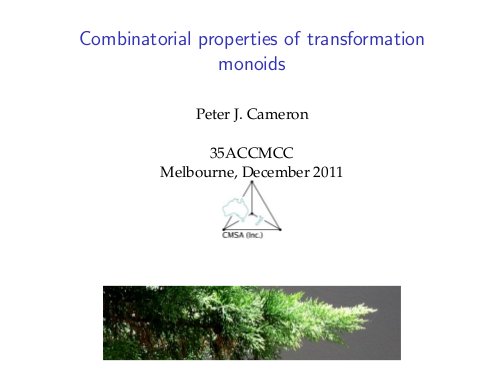
|
Further discoveries about the computer: its inbuilt picture viewer, called
"shotwell", has an edit mode which actually includes a few of the things I
use Gimp for, including "enhance" (which is roughly like levels), changing
colour intensities, crop, and so forth. Also the inbuilt PDF viewer, called
"evince", seems to have most of the functions of Acrobat reader.
I read for a while, and thought about splitting fields, but I was quite
tired, so I lay down and had a nap until it was time to start waking up
to go out to Ian Wanless' place.
|
While I was waiting in the lobby, it was brought home to me that I had come
without a bird book. Two birds, smaller than magpies, with very upright
stance and long tails, dark brown with black beaks, arrived, and flew into
the garden outside. I thought they were possibly wattlebirds, though they
looked a bit dark. The birdwatchers, when they arrived, thought this was
likely. I will look in the bookshop if time permits, though it is being
refurbished and the temporary shop has very limited stocks.
|
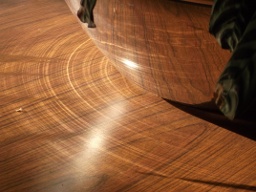
|
It was a good party with lots of old friends. Catherine Greenhill will be
in Durham for six months from January; I must ask her to come and give a
talk at Queen Mary. I had a long talk to Chris Monteith. Eventually Graham
was leaving so I accepted a lift home.
Sunday 4 December
After the party I had a good sleep, and woke with time to think about
rings of cliques, take a shower, and oil
myself before breakfast. The gregarious chaplain was there, and told me
that this is his busy day (of course!), but fortunately he doesn't have
to spend a lot of time reading the Sun-Herald since there is nothing to
read in the hundreds of pages of tabloid typescript. (This is the only
paper that appears in the College dining room.)
After breakfast, I wrote a GAP program to compute splitting-field equivalent
rings of cliques. (I still can't get the packages to load, but basic GAP works
very well indeed.) There are six equivalent graphs with the clique sizes at
most 10. So it is not an uncommon phenomenon, and we will struggle to find
a simple explanation. I read a bit, and looked on Google maps to see whether
there was anywhere nearby where I could walk. The maps for this part of the
world are very poor, strangely, but the best nature reserve seems to be just
across the road from the campus.
"The Bone People" is one of the most extraordinary first novels I have ever
read. This is the second time I have read it, but the first was long ago,
before I had been to New Zealand, so it resonates more now. I am rushing
through it too fast, but I bought another book at a table in the tiny market
outside the Campus Centre, about Queensland pioneers. I wondered if any of
my ancestors were in it; the index listed a Donald Cameron, but it was a
different Donald Cameron, not my great-great-grandfather. The book seems to
be mostly about the far north.
I went to lunch and found Catherine Greenhill poking at her food and talking
to two college staff. It seems that the party had gone on until nearly 3,
and she was feeling a bit delicate; off the leash, away from her two small
children, she had maybe overdone things a bit.
I debated whether to go for a walk or simply rest, and inertia (and the ache
in my shoulder) won out.
|
When registration opened, I walked over to pick up my stuff. There were very
few people there, and the organisers were busy, so I went back to my room,
intending to return later for the reception. The programme fails to say
which building and which rooms the lectures are in; this information is
available elsewhere, on the web page for example, but not good! I looked
at the map, which is a good medium-scale map of Monash and the surrounding
area. (I had tried Google Maps, but they have only very large and very small
scale maps of this part, surprisingly, and I couldn't get much of an
impression.) It is dire: the campus is surrounded by suburbs on all sides,
and there are few expanses of green and fewer walking tracks.
|
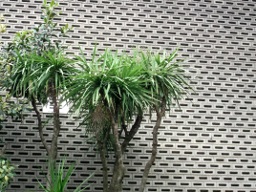
|
At dinner there was a table of eight mathematicians including Liz Billington,
Nick Cavenagh, Frank Bennett, and Charles Little. The food, cold meat and
salad, was the nicest meal I have had here so far.
Back to the reception with Liz and Nick, to find many other old friends
there including Don Taylor and Leanne Rylands, and the SymOmega bloggers.
I talked for a while and had a couple of glasses of wine, but decided not
to make a late night of it.
Birds seen so far: magpies, mickey birds, galahs, white cockatoos, small
green parrots seen too far away to identify, and what might be wattlebirds.
Monday 5 December
Despite my lazy day, I was very sleepy, went to bed early, and slept very
well. I woke bright and early to a beautiful clear morning.
Cheryl Praeger arrived as I was having breakfast, just in time for her opening
talk of the conference.
After breakfast, I headed over to the conference in good time, and found lots
of people gathered there. But not only was there no information in the
programme about which rooms the lectures were in, but no time had been
allowed at the start for introductory remarks; so Cheryl started a bit late.
It was a nice talk. What they have done is to take Delsarte's notion of
completely regular codes, strengthen it to completely transitive codes
(those where the automorphism group is transitive on each distance class
relative to the code), and then weaken that to neighbour transitive codes
(just assuming transitivity on the code and on the points at distance 1
from it). The best results were for the Johnson scheme, where the intransitive
and imprimitive cases have been completely analysed, and where primitivity
implies 2-transitivity; they are now steaming on with this.
Cheryl has taken to saying "cool" at various points during her talk; but so
also has the next speaker, Catherine Greenhill. The story of her talk is that
the analysis of rate of convergence for Markov chains goes back to a paper of
Diaconis and Strook in the 1980s; the crucial parameter is the non-trivial
eigenvalue of largest modulus. Sinclair put it into a more digestible form,
but referring only to positive eigenvalues. As a result, almost everyone
since has modified the Markov chain so that it has probability 1/2 of staying
where it is. This replaces the original transition matrix P by (P+I)/2,
all of whose eigenvalues are positive, so Sinclair's result is easily
applied. Catherine remarked that, if you are trying to prove a result about
rate of convergence, it is illogical to make the chain "lazy" in this way,
which can only slow it down. So she went back to Diaconis and Strook and
found a Theorem 2 which, if used in place of their Theorem 1, gives a version
of Sinclair which doesn't require positivity. She has been happily using
this on various problems.
At coffee I tried to find a toilet, and had some difficulty. It seems strange
that an area out of which five large lecture rooms open should not have any
toilets. So I went to the IT building where my office is, where I knew there
was a toilet. Later I found that there is one halfway down a long corridor
off which staff offices open. Do they really like hundreds of students
traipsing past their doors between lectures?
Next I went to the Hadamard matrices section, which was a kind of abridged
version of the conference at RMIT last week; it was even chaired by Asha Rao,
who had organised the RMIT conference. I didn't learn very much; but
Judy-anne Osborne gave a very nice talk.
|
Then it was lunch. Very few people bothered to go back to Mannix for lunch,
presumably preferring to pay money in the Campus Centre. The food was OK:
schnitzel and roast potatoes, or/and salad.
There is a remarkable sundial on the side of the campus centre building. For
each hour it has the analemma (the curve traced out by the sun through
the year), so that
when the shadow of the gnomon falls on the curve for midday, it is midday.
All you have to remember is which side is between the winter and summer
solstice and which is the other half of the year. (Later on this trip, Marie
asked me to explain why at certain times of year, sunrise gets later even
when the days are getting longer. I found this sundial was helpful in
explaining this.)
|
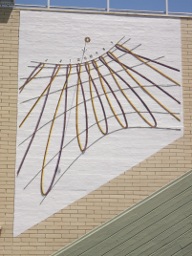
|
After lunch Brendan McKay gave a plenary talk, about the current situation
in graph isomorphism. At last there is a real improvement to nauty, a
program called Traces, developed by someone in Italy; Brendan is co-operating
with him and integrating his program with nauty, and claims that this
integrated form is now the fastest thing on the block.
I went to hear Graham's honours project student Zoe Bukovac giving a very
well-presented talk on certificates for chromatic equivalence or factorisation.
Nothing new, but it was a nice summary of Kerri Morgan's thesis.
Then I finished the afternoon in a mixed session, involving some complicated
counting using the kernel method, trees with the most maximum-size matchings,
constructing cubic graphs with small edge-disjoint cutsets, and a new
heuristic for Hamiltonian cycles. The second and fourth were worth remarking
on. In the second talk by Clemens Heuberger, he showed that "usually" there
is a unique tree on n vertices which has the largest number of
maximum-size matchings; its structure depends on the congruence of
n (mod 7). But the general case only kicks in at n=35;
for n=6 and n=34, there are two such trees. Not
so amazing, but the proof involved Euler's square bracket function used in
the theory of continued fractions. The last talk ran long overtime since they
decided to give a demonstration. They do seem to be able to beat anyone else's
program.
Then the CMSA business meeting began. All quite straightforward until any
other business, when an item brought by the committee was sprung on the
meeting. They want to make the Journal (currently their best money earner)
free on the web at the point of publication, rather than after a four year
delay as currently. They reckon that even if their income and printing
costs go to zero, they have enough money invested to last for 30 years.
The other reason is that their current balance is over $100K, which puts them
into a different tax category, so they need to spend some money! I think they
are being a bit naive about whether they can make the journal free on the web
and continue to get any money at all from subscriptions (most of these are
from universities who would love to get a chance to cut another subscription),
but I do agree with the principle of making it free. Unfortunately the meeting
soon degenerated into a bearpit; nobody understood how to proceed formally.
Eventually it was decided to look into all aspects and report to members.
At afternoon tea, the UWA contingent had suggested the pub, and recommended
a pub called the Notting Hill, a couple of kilometres north of the campus (the
opposite side from Mannix). I went back to Mannix to put down my bag and eat,
and said I'd see them in the pub. But when I had walked over there, there was
no sign of them. So I continued round the block. The setting sun was casting a
golden aura over the trees, and picking out red shoots on some of them.
Back in my room, I worked for a bit, wrote up my diary, and went to bed.
Tuesday 6 December
Another good sleep, less discomfort from the shoulder. Up early, read
email, showered, and oiled my sore bits before breakfast. Again, a
beautiful day outside: cloudless sky, bright sun.
Hanging from the ceiling of the dining hall are six pennants labelled
Bot | Mid | Top, East | West, referring to the six corridors of the college.
Each has a shield and a Latin motto. I am in Top West, so my motto is
"Dant vires gloriam". I talked to Keith Edwards at breakfast;
as treasurer of the British Combinatorial Committee,
he of course was rather jealous of a society that has so much money that
it needs to spend some. We wondered if we can learn any lessons from them.
Over to the conference, the first talk was by Liz Billington. It was rather
specialised stuff; but she did it very well. Afterwards she was presented
with a medal from the CMSA by Catherine Greenhill. Well deserved, too: she
has done so much for them (and for the AustMS).
Marcel Jackson talked about constraint satisfaction, along the lines of the
talk by Paidi Creed
I heard in London last week, the connection with polymorphisms. I hadn't
realised that, although Feder and Vardi had reduced the P-or-NPcomplete
dichotomy for CSP to the case of digraphs, there is more to be done if you
are interested in lower levels of complexity such as logspace or
non-deterministic logspace. This is what the talk was about.
After the break, I opted for designs rather than graphs. Frank Bennett's
slides were his paper, which he attempted to scroll down through, but
the technology kept letting him down. Diana Combe talked about Bhaskar-Rao
designs. At one point she said, "a corollary of the Hall-Paige conjecture,
which was recently proved". Not quite, I thought, and John Bray is not
likely to finish writing up the J4 case while he is under
such pressure from his bosses...
Back for the plenary by Keith Edwards about detachments of graphs. I am
afraid that my eyes kept closing despite my best intentions. (They have
changed the lighting in the room so that it is much darker.)
Cheryl wanted to talk to me about our paper, so we agreed to have lunch
together; but we ended up spending much more time talking about the bad
things that are happening in both our countries. She said that EPSRC
have just announced that post-doctoral fellowships are no longer restricted
to statistics and applied probability, but will now be restricted to
interdisciplinary work. I haven't looked, but I despair of those people.
They introduce some nonsense, and when the community complains, they put
it back one-tenth of the way to how it was and think they have done us a
great favour.
The after-lunch plenary was by Bridget Webb on infinite designs. She mentioned
that the problem of constructing a countably infinite perfect Steiner triple
system is open. I am pretty sure that you can build one with a free
construction, and managed to tell her so later.
I went to the matroid theory session, which had a lot of good stuff. Gordon
Royle included, along with some spectacular results, a bit of history. A
certain graph invariant was introduced and named by a "grand fromage" of
complexity theory not long ago. In fact, the important theorem about this
invariant had been proved by Douglas Woodall more than ten years earlier.
Furthermore, someone else (whose name I forget) had introduced an altogether
superior invariant, and proved the important theorem about it, ten years
earlier still...
Dillon Mayhew and his collaborators are trying to prove a theorem which
was announced by Dirk Vertigan ages ago, but he never published a proof
and neither has anyone else. (It is that counting bases for a matroid
representable over a given field is #P-hard.)
I skipped the last talk as I was quite tired, but no time for a proper nap,
since I had to have dinner in time to go on the penguin excursion. Dinner
was probably the best meal yet – steak – but, though it was tasty,
it was not specially tender, and by the time I had finished eating it with a
blunt knife my shoulder was quite tired.
We traipsed over to the bus stop. We had been split into two parties of 16,
since Ian didn't believe that the bus drivers would accept a group ticket with
32 people on it. I got on the first bus, with Kerri as guide. This took us
to Huntingdale station, where we caught the train a few stops to Malvern,
and then the tram to St Kilda. We got out at Luna Park, and walked along to
the pier and out to the breakwater at the end. On the way we saw a couple of
rainbow lorikeets in the palm trees.
|
It was a lovely evening: not too cool, not much breeze, and the sun sinking
from a cloudless sky. Leanne Rylands had just got back from a conference
in New Zealand where they had been given a bottle of wine from the
University vineyard, and had brought it and some paper cups in a desperate
attempt to get rid of it; but only she, Don Taylor and I were takers. We
managed to finish it, while the sun sank into the western sea. The wardens were
not at all bothered by this, but seemed pleased that we were enjoying ourselves.
The moon, with Jupiter close above it, shone down, while Venus was prominent in
the west. Some ducks, which Keith identified as chestnut teal, foraged on the
shoreline, while a couple of little pied cormorants fished, and a larger
cormorant (possibly a pied) flew over. A starfish crawled slowly on the sand
in the water below us.
|
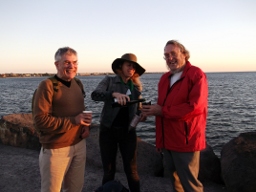
|
|
Then we headed down onto the boardwalk. We waited about twenty minutes, while
a teal fished just off the beach. Then the first penguin arrived. Soon we
had seen lots of them, and a few rakali (native water rats, long thin
creatures). Some of the penguins hurried up the beach: the breakwater is
made of boulders and they nest among the holes. Others stayed on the beach
to play, or went back in the water for a dip. Many cameras clicked; despite
warnings from the volunteer wardens, many people used flash, which risks
damaging the penguins' eyes.
|

|
A guide with a torch showed us two babies (full-grown but not completely
fledged) in a nesting hole. Everywhere you looked on the rocks, there
were penguins sitting or hopping about. Then, as if at a signal, they started
up a chorus of the most extraordinary sound. The best I can find to describe
it is "Tuvan throat singers on motorbikes": there was a rhythmic sound
alternating between high and low pitch, with quite different quality, and
underneath it a bass rumbling.
After a long time observing penguins, we headed back. At the start of the
pier were a couple with a big telescope, showing people the moon, Jupiter
(with three of its moons visible) and Venus. We took a look at Jupiter: the
three moons were well spaced out, and the red bands clearly visible. All the
operator asked was tips.
Back to Luna Park, now lit up and in bright noisy operation. As we approached
the tram stop, a tram came; we quickly ran up and jumped on. We did the
journey in reverse. The train was very crowded. The buses were down to one
every half hour; there was one a few minutes away, and we wondered what to
do if he only allowed one group on. But we all managed to squeeze on, and
were soon back at the campus and crossing the road to Mannix College.
Wednesday 7 December
I Googled "Dant vires gloriam": it means "strength gives glory", and is the
motto of a branch of the Hogg family. Their standard has a wild boar, but
the creature on the flag in the dining room is certainly not that! More like
a gryphon in a boxing match.
On the penguin-watching last night, two reflections. First, it seems to me
that Melbourne may be the only place where you can take a tram to see penguins
in the wild. Secondly, how remarkable that the wardens got cross with people
taking flash photographs or clambering on the rocks where the penguins live,
but were completely happy for three of us to drink wine out of paper cups
while we waited. I am sure that in Britain they would have invented some
rule to stop this.
|
The first talk was the highlight of the conference so far, an absolutely
lovely talk by Petr Vojtěchovský
on computational aspects of loop theory.
In fact the aspects were algebraic as well as computational. In a loop,
the multiplication group is the group generated by left and right
translations, and the inner mapping group is the stabiliser of the identity
in the multiplication group. In a group, of course, this is the group of
inner automorphisms; in a general loop, the inner mappings are not necessarily
automorphisms, so he defines the well-behaved class of automorphic loops,
those for which the inner mappings are automorphisms. So this class includes
groups. There are no simple automorphic loops of order less than 2500: this
uses the classification of primitive groups of these degrees.
There was much more. For example, Lagrange's Theorem holds for Moufang loops,
but what is remarkable is that the proof uses the Classification of Finite
Simple Groups. (Of course, for groups, the result is an easy undergraduate
fact.) It is not known whether Lagrange's Theorem holds for Bol loops.
(The Bol identity is a very small variant of the Moufang identity, a weakening
of the associative law which characterises groups).
|

|
The computation element came in the form of automated theorem provers,
which have had their greatest successes in this area. For example, it has
been shown that Moufang or Bol loops with inner mapping group abelian are
centrally nilpotent of class at most 3. (Of course, for groups, we have 2 in
place of 3; but 3 is best possible here.) The proofs are thousands of pages
long.
Then I went to Barbara Maenhaut's talk, which was more interesting than I
expected. She has a simple technique for re-colouring graphs to make the
degrees of each colour on vertices in a prescribed set nearly equal, without
affecting what is outside. The proof is entirely straightforward, but they
can use it to give simple proofs of Ryser's and Cruse's theorems on partial
Latin squares, among many other things.
Nick Cavenagh talked next. His big idea is that you have
to be flamboyant in a talk, so his talk (which was very nice) was interspersed
with five famous people from Hamilton, the most famous of whom (he has a
statue in the town, watched by a webcam) is the guy who wrote the Rocky Horror
Picture Show.
Then we got on the bus for the excursion.
First stop Killara winery for lunch and a short tasting. The style is
Italian; the lunch was antipasti (very very nice), bruschetta with various
toppings, and lasagne, accompanied by two of their wines, a Chardonnay and
one described merely as a "dry red". The Chardonnay was a lovely wine with
a quite stunning bouquet. After lunch we had another go at the Chardonnay
and also tasted their Pinot Grigio and Pinot Noir.
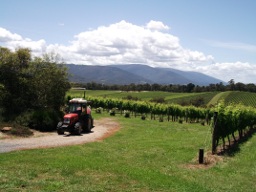
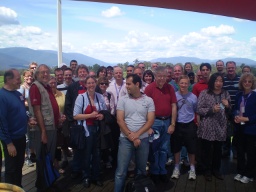
|
Then on to the Yering winery, a much more pretentious place, which claims to
be the oldest winery in Victoria (actually it started before there was such
a place as Victoria), though it didn't make wine between the arrival of
phylloxera in about 1910 and the wine revival in the late 1970s. We were
shown round and given a tasting by an irritating guy whose favourite word
was "awesome". The tour showed us very little, we got to see down into the
barrel hall and the fermentation hall through awkwardly-placed windows.
The wines I thought also over-rated, and certainly we were drinking them
far too young. But their Champagne-style pink Chardonnay/Pinot Noir slipped
down easily. The others were a Chardonnay (much inferior to Killara's) and
a San Giovese red, with too little body and too much tannin. Their dining
room (which we didn't get into) was architect-designed, because they are
not allowed to mess around with their old heritage buildings; this makes an
odd balance.
|
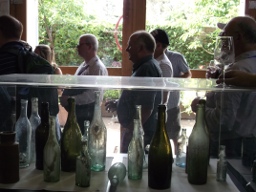
|
|
Finally to the Dandenong forest for a short walk. We had been promised that
we could feed the birds (crimson rosellas, galahs and sulphur-crested
cockatoos), but the kiosk was shut. Liz and I did all three short walks;
there were long walks, some passing through, which would have been nice
but time was pressing. As well as the abovementioned birds, we saw several
kookaburras, one very close up sitting on a sign. The trees in the forest
are claimed to be the tallest flowering plants in the world; they were very
impressive. The understorey was mostly tree ferns but with some other stuff
including (I think) rhododendron. There were quite a few spiders, and some
unimpressive fungi. The closed kiosk also meant no chance of a cold drink.
|

|
On the four legs I sat next to different people (Thomas Britz, Padraig
O Cathain, Catherine Greenhill, and Liz Billington), and had some good
conversations. Thomas encouraged me very much, by saying that he has
just discovered that two axioms of academic life (that you should strive
to be promoted, and that you should strive to get research grants) are
both false. He cheerfully said that he has as much money as he needs; he
feels bad because he gets twice the Australian median salary, and also
(for a different reason) because wicked bankers get far more than he does.
Padraig was interested in the stuff about Hadamard and conference matrices,
and I promised to send him something on the next update.
The bus dropped us back at the campus right on time at 7. I had dinner
in Mannix (something that looked rather like cat food, and was probably
the leftover steak turned into a stew), and then went to my room to transfer
photos, write up my diary, and make some last-minute adjustments to my talk.
Thursday 8 December
My internal clock is re-setting. I slept until after 6:30 today, and forgot
to oil my shoulder before breakfast.
The first talk was by Tony Evans on orthomorphisms. He picks his favourite
group, and looks at the graph whose vertices are orthomorphisms which are
orthogonal to the Cayley table; two of them joined by an edge if they are
orthogonal to one another. A nice exposition, including the Hall–Paige
conjecture; his story was that John Bray had emailed him in November 2008
(I think) saying that he had done J4, the last open case,
but no write-up has appeared. (Later, someone else, I think it was Diana Combe,
asked me about John; I explained the situation but said I had no doubt that
the result was correct since John is very reliable.)
I listened to David Fear, a student of Ian Wanless, on cyclotomic
orthomorphisms, then after tea a talk by Gunter Steinke on Minkowski
planes, and a lovely talk by John Bamberg on a geometric construction of
the G2(q) hexagon. Then it was my talk.
I started by promising that I wouldn't be listing famous people from London,
and remarking that we had already been told about two "famous" people from
Toowoomba.
I had decided to cut quite a bit from the synchronization part so I could
talk about the problem of two random elements, but this would still leave
no time for our recent work on regularity. It all went well. Though there
were no questions after the talk, quite a lot of people asked me questions
later.
At lunch, I went back to my room, made some small corrections to my slides
and put in some references, and sent them off to Ian Wanless. Then I walked
back to the campus, bought a sandwich and a Bundaberg ginger beer, and sat
in the sun enjoying them. This was the hottest day so far, the temperature
said to have reached 30. This meant that I was rather sleepy in the afternoon
sessions.
David Wood, a young guy who was Graham Farr's student. gave a lovely
survey of the Robertson–Seymour graph minors theorem, concentrating
especially on the structure theorem, which he explained well and put into
context nicely. Then I heard a talk by Johann Makoswki, basically a critique
of Jaeger, Vertigan and Welsh. They use Turing complexity to state their
result, but when they come to evaluate the Tutte polynomial at a non-computable
real number they implicitly use something like the Blum–Shum–Smale
model, where a real number is a "black box" and one field operation costs one
unit. I am unconvinced by this kind of thing but I agree that there is an
issue to address when JVW say that the value of the Tutte polynomial is #P-hard
to compute at all but a few special points and curves.
After tea there was a mixed bag of things, from antichains of Brualdi's
generalisation of the Bruhat order to matrices with constant row and column
sums, maximal antichains in the Boolean
lattice, linear extensions of posets (joint work
with Graham Brightwell), and Abdullahi Umar talking about his construction
of interesting sequences and triangles of combinatorial numbers as counting
subsets of semigroups of partial maps.
|
I had bought at lunchtime a bus ticket, but Ian had announced that there would
be some group tickets. So I felt under no pressure; I put my bag back in my
room and wandered back to catch the bus. Ian counted two groups of 12 onto
the bus (not including me), and we were off, by bus and train to Flinders
Street, across the street to Federation Square, and then drinks and dinner
at a restaurant at the back of the square.
At the pre-dinner drinks, Catherine asked me to say a few words of thanks to
Ian. I said I was happy to do it but also told her that I am chairing a session
with three of the four organisers speaking tomorrow, and was planning to say
something at the end of that. We agreed that I would do both; they are
conveniently differentiated.
|
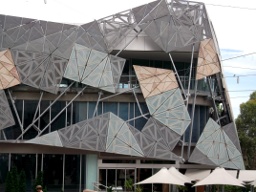
|
Dinner was in a nice Chinese restaurant; no tea, but plenty of food and wine.
Indeed, a really nice banquet. I sat with Liz Billington, Don Kreher, and
three South Australians who work on Hamiltonian cycles. One of these three
had been taught statistics by Chris Brien.
The food was rather slow coming, but after the last course except for fruit,
Ian rang his bell, and said a few thank yous. He launched straight into
the next thing, and I was forced to interrupt to say my piece. Michael Brand,
a rather nerdy student from Monash, had prepared a sheet of mathematical
problems, and Ian invited anyone who had solved one they hadn't seen before
to come up and present it to earn a free drink. I had solved two (and knew
the solution to another, the 100 prisoners problem), but decided to be a
shrinking violet; I have done my bit. Some of the proposed solutions were
wrong, but we had good entertainment.
After the fruit we left to catch the 11:01 train. While we were waiting on
the platform, a somewhat drunk, powerfully built brown man with a gold
earring came up and accosted us, claiming to be a maori king, and telling
us off in foul language. Some people, including Liz, were quite bothered, and
moved down the platform; but he got into our carriage anyway. At a certain
point, he came up to me, shook my hand, and grasped me by the shoulder. I am
sure he meant no harm; but he had a powerful grip, so I had to shout at him
to let go. He was quite crestfallen and got off at the next station, one
stop before the one he wanted. Wouldn't it be funny if the touch of a maori
king sufficed to cure my shoulder?
Anyway, the rest of the journey was uneventful and I was back in my room
before midnight.
Friday 9 December
I slept till 7, and after showering and oiling, I wasn't down to breakfast
when it started. But I was in good time for the first talk.
Patric Östergård talked about his latest heroic calculation, finding
the number of Hamilton cycles (Gray codes) in the 6-cube. It was a little
dry, but he described the method clearly enough. As a joke against Brendan,
who was chairing the session, he remarked that the number was a 23-digit
number beginning 358..., and 358 is the dialling code for Finland, this
must be significant surely? After he finished, Brendan responded that he
must have made a mistake, the number must be 61... .
Janos Barat gave a charming talk about dismantling a cube made up of
n×n×n small cubes. The rules assert that a
cube can be removed only if
it touches precisely three other cubes. It is a nice exercise to show that
at least n2 cubes must remain at the end of the process.
After coffee, I went to the matroid session. First, Thomas Britz gave a
nice introduction; it is quite remarkable how he refused to believe that
certain connections between matroids and codes couldn't exist, and went on
and found them. The talk was ostensibly about vector matroid chains, but
he didn't say much about this because of running out of time, and he didn't
seem to have much new stuff. (He said he'd offered this talk to try to get
his thoughts in order.)
Geoff Whittle departed a bit from his theme (which was the second of his
Aitken lectures) to speculate about various things including the possible
existence of a "Szemerédi regularity lemma" for matroids over a finite
field.
I had lunch with Michael Giudici and chatted about various things, then talked
to Bridget, Darren and Daniel; she has got the other two interested in infinite
designs, and we talked a bit about the existence of perfect ones. I think I
managed to convince them that there is really no point looking for anything
larger than countable, but we discussed how one might show that there are
infinitely many examples. This may turn into a paper. One amusing thing was
that she asked me why I had entitled the note I sent her "Large Perfect
Steiner Triple Systems". Of course, Large should have been \Large.
|
Then to the final session, which nearly caught me out by starting half an
hour earlier than usual. I was chairing the session in the main room, which
consisted of three miscellaneous talks (Michael on GQs with large automorphism
groups, Shoetsu Ogata on something about lattice polytopes which as he said
was really algebraic geometry, and Ludmilla Scharf on reconstructing a polygon
from the set of lines which are its sides extended. Then the home team put
up three excellent talks, by Kerri Morgan, Graham Farr, and Ian Wanless. The
only glitch was that Graham had come along with a memory stick which didn't
have his talk on it, and had to go back to his office to get a copy; he got
teased after that. Ian talked about the number of subsquares of a Latin
square. He has proposed that next week he and I should think about the
question whether the number of subsquares of order 4 is maximised by the
elementary abelian 2-group.
|
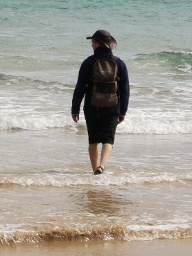
|
Finally it was over and we retired to the maths common room for the
survivors' party. I talked to a lot of people, getting more and more tired
(typical after conference feeling as the air drains out), and then took
myself home for dinner. Ian has offered to take me to Wilson's Promontory
on Sunday if I can be ready to leave at 6am.
The dining room in Mannix was dark and deserted. I went in and found the
housekeeper explaining that the meal hours had been reduced because there
were so few people staying, and showed us where the food was hidden. It
turned out to be far and away the best meal I have had there, with oysters,
prawns (both ordinary and king), kebabs, and a very nice salad of spinach,
pumpkin, feta, and pine nuts. However the ice cream cabinet was locked, so
I finished up with fruit.
I went off to bed and had an early night.
Saturday 10 December
The traffic noise from Prince's Highway, not far from my room, was
unusually loud last night, and woke me a couple of times. While awake,
I thought about Ian's question on subsquares of order 4, and managed to
show that the number is at most
n2(n−1)(n−2)/96, with equality
(for n>4)
if and only if the square is the Cayley table of an elementary abelian
2-group. The next question would be, what is the maximum if you don't
have this square, in particular, if n is not a power of 2?
Breakfast was a rather quiet affair, and a sign-up sheet for meals next
week had appeared. So I signed up for my dinners during the week, even
though I may well have to change the plans, depending on events.
I was debating whether to go out to the Dandenongs for a walk (quite a long
train ride) or to just go into town. It was decided for me when I felt very
tired after breakfast, and lay down on the sofa and took a little nap. When
I woke, I worked for a while preparing a talk for next week, and then set
off.
It was a tediously slow journey. First, I discovered that only one of the
three bus services to the University runs on Saturdays, and only one every
half hour. I had just missed one, and had a long wait. The Campus Centre
was closed, so I couldn't even get a ticket in advance. Eventually the bus
came and filled up to rush-hour levels. At the next stop, even more people
crammed on. I got off with relief at Huntingdale, surprised that so few others
did so too.
I went into the station and got my ticket. Just as I was about to validate it,
a voice came over the tannoy, clearly someone who could see us even if we
couldn't see him. After a preamble to get our attention, he told us that there
would be no trains until Monday morning, and we should go out and get a bus.
Fortunately the rail replacement bus came very soon, and took me to the next
station, Oakleigh, where there was a train about to come in. People piled on,
and off we went. It was City Loop, so a lot longer to Flinders Street than
the direct train.
At Flinders Street, it was past lunchtime, so I bought a baguette and ate it
in Federation Square. Then I went to the tourist information centre. They had
timetables for the line to the University, but not for the line to the
Dandenong Forest. However, they did have some leaflets about short walks in
the city centre, so I took some of these. I decided to do the garden walk.
I was crossing Princes Bridge when someone called me by name. It was Stu
Whittington, one of Thomas Prellberg's collaborators, who was in Melbourne
on a research visit to Tony Guttman, with his wife. They are leaving tomorrow.
After a spell through various public parks, I came to the botanic gardens.
There I spent a very happy afternoon wandering around. They have a fine
collection of trees, some majestic specimens on their own, others planted
to make natural-looking woodland. There are two very fine cactus gardens,
one of them on the side of a simulated volcano. Some of the cacti were in
flower. All three main species of araucaria that grow
here, as well as one I didn't know, Captain Cook's pine, which is like a
Norfolk Island pine with a curl at the end of its moustaches. There was a
jacaranda and several eucalypts in bloom, and waterlilies on the lake.
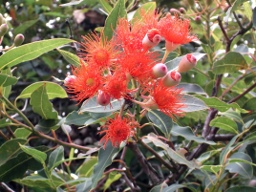
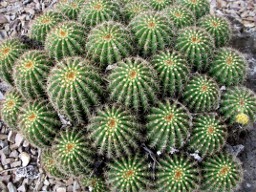
The scents were very striking, but the best thing of all was the huge
quantity and variety of birdsong, including some resonant chiming calls which
I think could have been made by bell miners. I saw various birds including
tickeaters, magpies, swamphens, ducks, gulls, etc.
Finally I left the gardens and followed the tour back to Fed Square, then
crossed over and reversed the tedious journey (not quite so much waiting
this time) and went back to my room.
I spent the late afternoon and early evening gimping my photos from the
day's walk, writing up my diary and my notes from the conference, and doing
my laundry. A shower came over, which only seemed to increase the humidity
without reducing the temperature.
While I was doing this, there was a knock on the door, and there was Ian
Wanless. He was looking for Petr Vojtěchovský, who is it seems
the person
who will drive us to Wilson's Promontory tomorrow, and according to Ian's
list is staying at Mannix. I said that I hadn't seen him in any meals. The
housekeeper was with him; she had a list showing who had booked which rooms,
but not who was actually living in which room.
Sunday 11 December
The rain returned after I went to bed, and there was a spectacular display
of thunder and lightning which went on for quite a while. The combination
of this and some discomfort from my shoulder, along with my having set my
alarm, made for a disturbed night's sleep. Certainly no chance of seeing
the lunar eclipse!
|
I woke at 5, and checked whether there was any information on the plans.
Ian had emailed me and Petr, having failed to find his room in Mannix. So
I had a nice warm shower and a leisurely cup of coffee, with plenty of time
to get ready before 6.
I went out about 5 to 6, after a small panic when the locked door to the
college wouldn't open; but the side door was working. It was raining, and
the streetlights were casting shadows of gum leaves on the wet street. After
about ten minutes, a car showed up with Petr driving and Ian and Tony. I got
in, and we were away.
|
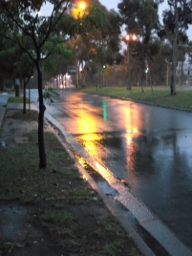
|
First, a long slog through the boring Melbourne suburbs. Then some flat,
rather boring country (I saw on the way back that it was very close to the
sea, and the creeks had little boatyards; this couldn't be seen through
the rain). Then we got into the Gippsland hills, mostly gently rolling but
some a bit more precipitous; many cows ate the rich green grass, and I saw
a herd of alpacas and a disused coal mine.
|
We stopped in the country town of Leongatha at a service station, and I
went in after some breakfast/lunch. The woman in the shop said she'd had a
whole fridge full of sandwiches, and sold them all. So I had to make do with
a pie, a couple of caramel fingers, and a bottle of water. After the hills, it
got flatter, until we came to the entrance to the National Park. The
instructions said to take a leaflet, but there were none to take.
A little way down the road we had to stop while three emus crossed the road
and disappeared into the scrub on the other side, before Tony (a serious
photographer) had got his kit out. A little further, we saw two kangaroos
by the side of the road. They were tame enough to let us get quite close
before bounding away. As we stood there, a kookaburra laughed, and for the
first time on this trip I heard the lovely song of a butcherbird.
|
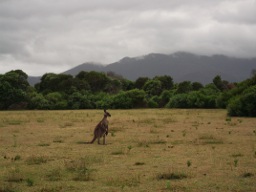
|
|
Petr and Tony had done some planning, and suggested a walk to the Tongue, a
peninsula sticking out to the west about halfway down the promontory: this
is the point where the sandy dunes give way to rocky headlands. Many
of the walks were closed because of the severe floods they had in March, but
this one was open. We parked in the Darby River car park and set off up the
hill, the path surfaced with wooden slats where it got steep. There were
signs that the scrub was regenerating after some old fires. Higher up there
was rosemary and other tough shrubs, and later on some grass trees.
|
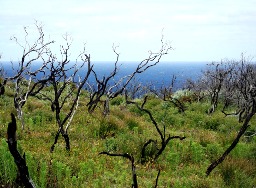
|
|
At the top of the ridge, we got our first view of the amazingly blue sea,
full of islands, Down this ridge, we saw that there was a tiny beach in a
cove just off the track. We found another track leading down (it was called
Fairy Cove). I was leading when I came to a little flat patch of grass, with
a wallaby calmly grazing. He watched me (and let me take his picture) while
Petr came up. But then, trying to move carefully, I disturbed the wallaby's
mate, unseen very close to the track; they both bounded off.
|
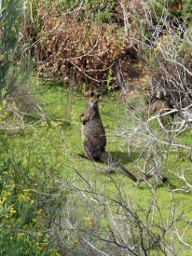
|
|
The beach was very pleasant, but I noticed one oddity: no shells. There was
an old rusty piece of machinery whose purpose we couldn't guess. We took
one another's photos, and then headed back up and on to the Tongue.
The view from here, up and down the coast, was splendid, with waves crashing
on the rocks and sending spray high into the air. We stayed for a while, with
fantastic views of islands in the blue sea, huge rocks being drenched by the
breaking waves, and little concealed gardens of flowers. The
others scrambled on the rocks a bit, but I didn't want to risk a fall. Then
we set off back. Petr and I went first, and after a while stopped to wait
for the others. While waiting, we saw a wattlebird, a blue fairy wren, and
(inevitably) quite a few crimson rosellas.
|
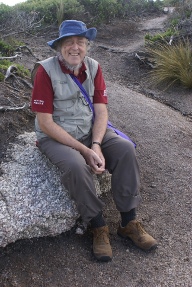
|
|
Back to the car, we had a bite to eat, and then drove on to Tidal River,
the nearest thing to a town on the promontory: it has a tourist information
centre and a shop with essentials for campers. I bought some chocolate milk
and an apple from the shop to augment my lunch, and felt quite satisfied.
We walked down to the beach, seeing on the way a king parrot in a tree eating
from the blossoms (but he wouldn't come out to have his picture taken). It
is a long flat beach, this time with a few shells and many cuttlefish. At
the far end is a mountain topped with striped rocks which give a good
impression of a huge face. Tony, whose back was giving him trouble by this
time, waited for us. We walked back along the river – at least that was
the plan, but the path had been washed away in the floods, and we had to take
off our shoes and wade for some distance through the warm salty water.
|
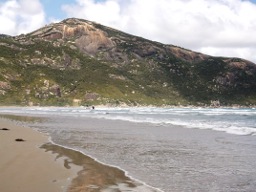
|
|
Back to the car, Ian suggested walking to Squeaky Beach; Tony didn't want
to walk but was happy to drive the car round. The direct path was closed
but there was a longer path going right over the ridge; we took that, past
many grass trees. Near the top there was a huge cleft boulder; Petr climbed
it but Ian and I continued on the path which we found led more easily to the
top. While we stood there, several kookaburras flew by.
Down the other side, round the corner, and down to the beach. At one point
on the path was a seat, a memorial to a young couple who were swept off the
rocks and killed by a big wave, which ended with a moral lesson: "Keep to
the path". The beach lived up to its name: the dry sand made a satisfying
squeaking noise, especially if you scuffed it as you walked. But it was
hard going, so after testing it out, we walked on the firmer wet sand.
|
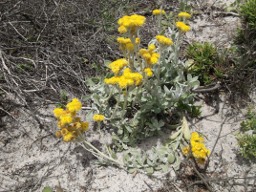
|
Tony was indeed waiting for us at the other end, where we piled in the car
and drove back to Melbourne. In the darkness of the morning, I hadn't noticed
that the road goes very close to the sea; little tracks lead down to boat
ramps. Then into the suburban sprawl. They dropped me off at Mannix.
The college dining hall opened fifteen minutes late, and when we got in,
we found that they had prepared individual
plates of cold fatty roast mutton, congealed gravy, and cold roast potatoes
and boiled vegetables. The idea was to microwave this, and the microwave had
been preset so we wouldn't make a mistake; the setting made the food
lukewarm but left the plates stone cold, so it was all cold again when we
got to the table. I remembered why I don't like microwaved food!
Apart from me, there were a mother and daughter, and a
father and son, doing the round of universities for admissions.
I didn't stay late but went back to my room to organise my photos (I took
far too many, but could easily have taken lots more), write my diary, and
prepare a talk. (Ian thinks that Graham wants me to talk at 11am tomorrow.)
Monday 12 December
I slept well after an active day in the fresh air and sunshine. I got up
and enjoyed a shower and cup of coffee before going down to breakfast, and
was still in my office well before 9.
There was, to my relief, an email from Graham saying that I will be talking
on Wednesday and Thursday, since Geoff Whittle is still here and will talk
today at 11. Another email invited me to a tour of the old Melbourne
Observatory at the gate to the Botanic Gardens, which I passed on my walk
on Saturday; he is a volunteer there and there is a public tour tonight.
He will pick me up after dinner. He also forgot to say in the email, but
told me afterwards, that we are invited to dinner with Jacinta Covington
on Saturday night.
I decided it would be prudent to carry on with preparing my first
talk anyway. At 10, I got a bit of a shock to hear someone calling out,
"Coming to the seminar?" I checked Graham's email and it did indeed say 11,
so I assumed it was a different seminar.
Geoff gave his talk about binary matroid minors, the other one of his two
Aitken talks, even using the same slides; but the accompanying text was
quite different. Geoff is really a master expositor, and worked hard to
make us understand what lies behind. For example, it follows from the
work of Robertson and Seymour that any minor-closed class of graphs has
a polynomial-time recognition algorithm: by their theorem, there are only
finitely many excluded minors, and these can each be checked in polynomial
time. On the other hand, he said it is conceivable that a class such as the
knotlessly embeddable graphs is recursively undecidable. The problem is,
we have no general method of computing the excluded minors for a given
class, and if they are not computable, then the Robertson--Seymour method
will not work. I am not quite sure that I have my head round this yet.
He reiterated that he and his collaborators have bravely decided to wait
until they have pushed the results from the binary case to the general case
of matroids representable over a finite field. (They decided after some debate
that if they published the binary result first, it would be hard to get up
enthusiasm for the generalisation.)
Then we went for lunch in the good cafe on the other side of the campus.
Good food, mostly vegetarian, Italian-inspired. After lunch, we headed back.
Graham was going to the Campus Centre, so I went to the post office and
bought stamps for Marie's and John's Christmas cards. We had agreed that
Graham, Kerri, Daniel Delborgo (the tame number theorist on the project)
and I would meet at 2, which we did, and kept going until well after 5.
|
During a good session we looked at what Kerri and Daniel have already done
about the theta-graphs with three paths. They have shown that, for one
particular sub-family of these, if the discriminant is a non-square, then
the Galois group is necessarily the symmetric group. They had guessed part
of the formula for the discriminant, but were stuck on one part. So we
tackled that.
I was able to spot the pattern of the monomials which occur in this term, and
some part of the pattern of the coefficients, but we were left with the
situation that we don't fully understand the rest. We decided to break and
think about it.
|
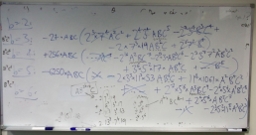
|
Daniel had to go, but Graham, Kerri and I chatted about the weekend for a
while. Eventually I left to go back to Mannix.
Dinner was on the same principle as last night: a plate of food to be
microwaved. But it was considerably better, being pasta and meatballs (which
re-heat better than fatty mutton), and the microwave had been set to heat
the food for longer, so that it was almost warm when I ate it.
I retired to my room to write my diary for a while until time to be picked
up to go to the Observatory.
I arrived a bit early and waited in the road. As I waited, the sun dropped
below the clouds and the low evening light illuminated the leaves on the
gum trees, creating a remarkable effect.
Graham arrived, a bit later than he said, but still in good time to drive
in to the Observatory, which is at the gate to the Botanic Gardens, and is
now administered by the Botanic Gardens. He left me to read the information
boards scattered round the site while he went in to set things up for the
evening. As dark fell, a magpie carolled, and fruit bats roosting in a tree
set off on their night's work.
We began with a stroll around the site, with explanations of its origin and
purpose. The original motivation had been to provide accurate time to the
ships in the harbour, so it had been founded there in the 1850s, and moved
to its present site ten years later. As well, it was involved in meteorology
(producing weather forecasts for the newspapers), and generally was the kind
of scientific enterprise appropriate for a colony newly rich on the back of
the goldfields. Later it became part of an international effort to produce
accurate star maps, and installed a reflecting telescope and teams of
(female human) computers for this purpose. But Federation was the beginning
of the end, since the Federal government took charge of astronomy and started
moving everything to Canberra (which in any case had better viewing weather).
|
Then we were divided into two parties. I was in a group which went first to
the telescope built and installed to view the transit of Venus in 1884
(though it was used for other things too). The original mechanism is all
there in working order, including the clockwork which rotates the telescope
to keep it pointing at the object being viewed. Graham was working this
telescope, and pointed it at Jupiter – it was already fairly cloudy and
not much else was visible but Jupiter could usually be seen, though it faded in
and out. I saw the cloudbands and the four Galilean moons very clearly.
|
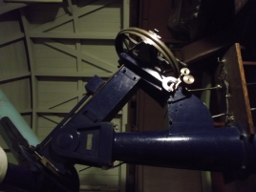
|
|
We swapped, and Graham's colleague Ken showed us the reflecting telescope.
By this time, even Jupiter had disappeared, so we were reduced to looking at
the illuminated sign on the ANZ building in the city centre, about 2km away.
At the highest magnification, even the wires connected to the neon tubes were
clearly visible. The image was remarkably clear, testifying to the accuracy
of the mirror. Ken spiced his commentary with remarks about dark energy,
whether the Mayans knew about the galactic centre, how the moon and comets
were responsible for the origin of life, etc. At the end, seeing that I had
a camera, he invited me to photograph the ANZ sign. Unfortunately, I needed
to focus the camera on infinity, and I haven't figured out how to do manual
focus, so this was not a great success.
|

|
Then the demonstrators packed up while we chatted, and then Graham drove me
home.
Tuesday 13 December
Though late to bed, I slept well, and again had a cup of coffee before
breakfast. The chaplain was there; he has been turfed out of his room
for a couple of days while they remove asbestos from that block. He seemed
remarkably unperturbed, and expected to move back in while they did the
restoration work around him. We talked about the University of New England
where he had been for a time. The government forced them to give lots of
money to a campus in Lismore, which proceeded to declare itself independent;
he said that this university gives degrees in surfing, and that at their
first graduation, some of the female graduands showed up with academic
robes over bikinis. He didn't think much of this.
I went to the department and worked for a while until Kerri and Daniel came.
We had a hard day's work. In the morning, we tackled the problem we had been
on yesterday. We have established that the unknown coefficients form two
Pascal-like triangles. Daniel had guessed the formulae for the coefficients
down the sides of the two triangles, and so all that remained was to guess
the recursive rule (which for regular Pascal is "take the sum of the two
numbers above"). However, we completely failed to find a way to make it work.
Then we turned to another problem. Daniel was interested in finding an
explicit graph for which the splitting field of the chromatic polynomial
is the same as the splitting field of x3−2.
Adam Bohn's work shows that such a graph exists, and indeed gives a slightly
complicated recipe to construct it. So we looked that up and calculated. The
smallest such graph turns out to have over 3000 vertices; even using the
equivalent polynomial x3−2k3
instead, where k is an integer, the smallest graph we found had more
than 2200 vertices. No wonder these things were hard to find when James
Sellers was looking for them at the INI in 2008; and this did give me a
greater appreciation of what Adam managed to achieve!
We broke for lunch, and they took me to a restaurant not far away which looked
Japanese on the outside but turned out to be sort of Singapore or Indonesian.
I had a bowl of noodles and stuff, which was very good.
Back to the fray, and we turned to a challenge I had set the group last week:
take some very simple graphs (rings of cliques) where the only non-linear
factor of the chromatic polynomial is a quadratic. It is very easy to tell
when two of these have the same splitting field. But can you find some
graph-theoretic operations which demonstrate this in a constructive way?
Kerri had to leave to go to a meeting, so Daniel asked me if I would mind if
his student Lloyd came and talked to us. He is working on a problem in
non-commutative Iwasawa theory which boils down to something to do with the
representations of the group defined as follows: let R be the ring of
integers mod pn. Then take the additive group of the
sum of d copies of R, and make
the semi-direct product with the multiplicative group of R. They have
done the case n=d=1 and are struggling to get further.
I may be able to be of some
help working out the representations of the group.
I was quite tired by this time, and found my eyes closing while Lloyd was
presenting his argument. Daniel was also tired, so we took a break while he
finished his session with Lloyd and I went down and sat in my office for a bit.
Kerri and Graham were late back from their meeting, but eventually we got
back to work. We explained in detail to Graham what we had been up to during
the day. He got interested in the last problem about rings of cliques. We
came up with a nice conjecture, not precisely formulated, which would go
something like this. Let G and H be graphs whose chromatic
polynomials are each a product of linear factors times a single non-linear
factor (so far this is typical behaviour for a graph); suppose that the
non-linear factors are f(x) and f(x−k)
for some integer k. Then there are some simple operations
on G and H which involve adding vertices joined either to
everything or to a
clique (these have simple effects on the chromatic polynomial: the first
shifts it, the second multiplies by a linear factor) to obtain two graphs
which have the same chromatic polynomial. The point is that Kerri, in her
thesis, looked at an algorithmic way of finding "certificates" to guarantee
that two graphs have the same chromatic polynomial without actually finding
the polynomials (which is computationally hard).
|
I left him to it, and went back to Mannix. The dinner was
processed chicken fingers with undercooked potatoes, to be microwaved, and
only one other person was eating.
Then I went back to my room. Despite the wireless signal being extremely
weak, and there being some problem with copy-and-paste in Emacs, I managed
to produce slides for both of my talks this week. The second talk will be
about Dennis Lin's conjecture on hot and cold matrices, so I was able to
take a picture of the taps in the bathroom, put it on the computer, shrink
it down, and incorporate it into the slides. Certainly what I am
travelling with (computer, camera, and USB card device) is adequate for
technological challenges like this.
I decided to have an early night.
|
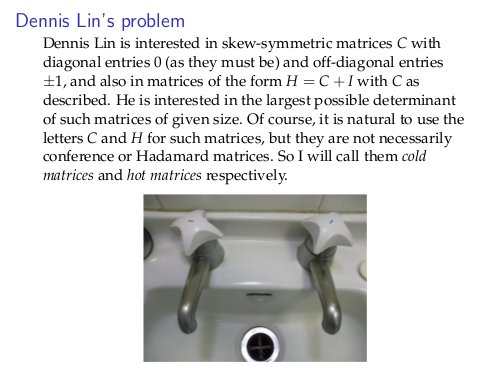
|
Wednesday 14 December
I woke refreshed after a good night's sleep. On the way to breakfast I met
the cleaning lady and stopped for a chat. The conversation turned to
grandchildren, and she told me that she is expecting her fourth any time
now. As I walked into the dining room, I felt a great sense of well-being,
for maybe the first time on this trip.
I got to my office a little after 9, and didn't press myself very hard to get
anything done, since my talk was at 11. About 10:45 I went out and tried to
make myself a cup of coffee, but the machine defeated me: it had pictures
beside buttons which were quite not clear, and first I pressed one which
sent a jet of boiling water spraying out through one nozzle, and then another
which sent a jet of boiling milk spraying out through another nozzle; after
cleaning up, I gave up on it and went back to my office. But soon after that,
Kerri arrived (she is just down the corridor) and we went downstairs.
There is another common room and coffee machine on the ground floor; this
time I let someone else make me a cup of coffee. Kerri had brought what she
described as a "paperless Christmas card", a plate of rocky road. She claims
not to be a good cook, and she has people with nut allergies in her family,
so there were no nuts; but she had made it with real Lindt dark chocolate,
which is the most important ingredient, so it ended up being the best rocky
road I have ever tasted.
The talk went well, with lots of people there, and maybe 20 minutes of
questions (mainly but not entirely from Graham and Ian) afterwards. (I had
described it as "matroids meet orthogonal Latin squares" to try to get them
both interested.) Then we went to lunch, in the traditional place, where I
had meatballs and rice with a large quantity of salad, and a ginger beer
(New Zealand, and not very flavoursome).
Over lunch, Ian gave me my assignment for his problem: it is to extend
the result for subsquares of order 4 to arbitrary 2-power order. There is
a function of n which gives the right answer in the case of an elementary
abelian 2-group; the task is to show that it is an upper bound for all n,
and that it is attained only when n is a power of 2 and the Latin square
is an elementary abelian 2-group.
After lunch we went back to Kerri's office and started work again. Kerri had
to go to a session on mentoring (I am not absolutely sure whether she was
mentoring or being mentored; I think the latter) for an hour in the middle,
but we pressed on. We made good progress. If two graphs have chromatic
polynomials which are each the product of linear factors and one irreducible
factor (which, by the way, I believe is typical for a randomly chosen graph),
and if the irreducible factor of one is a shift of that of the other, then
we have a way of tampering with the graphs to make the chromatic polynomials
equal, preserving 2-connectedness. This is a first step towards a
certification procedure for splitting-field equivalence of chromatic
polynomials. But the second step, where the irreducible factors satisfy
g(x)=f(k-x) for some k, defeated us. Examples show that this is very common,
much more common than one might expect; and we couldn't find a graph
operation which introduces this kind of transformation. (Adam Bohn has such
an operation on a special class of graphs.)
After a busy afternoon, it was time for me to go back to Mannix for dinner.
The college excelled itself tonight. I got there a little after 6, to find
that there was no food: there were five people dining, and they had only
put out four plates of food to be microwaved. So one of the employees who
had taken one of the plates phoned the housekeeper. She said that I should
go to the pub down the road and eat there, and they would pay the bill.
Indeed, out the back gate (which took me a little while to figure out) and
five minutes' walk down Princes Highway was the Monash Hotel, in which was
Dooley's Bar. Not very crowded: a few workmen in orange overalls outside,
and two women eating at a table in the corner. I ordered a pie and a pint,
ate them (tolerable, and much hotter than I would have had in Mannix),
and then came home.
I worked on some of Ian's questions for a while. I convinced myself that
the orders of abelian groups on which an element of order 3 can act
fixed-point-freely is quite dense (gaps between successive numbers should
be of order the square root of n if I am not mistaken). For such an
n, there is a group of order 3n with n subgroups of
index 3, giving a Latin square with many
subsquares of order 3. Then I started work on subsquares of order
2d.
I made a bit of progress, but lay down to think further about it, and
went to sleep.
Thursday 15 December
I had a dream, from which I woke up into another dream, and evenntually
I woke up out of this dream too and at last reached the level
that might be reality. I lay there thinking about subsquares of order 8,
and realised that I can do this case, and with a bit of work can do arbitrary
powers of 2.
This diary must be quite boring at the moment. I remember a spoof diary of
Mark Knopfler, where every day the entry was "Got up. Played the guitar.
Went to bed." This must read a bit like "Got up. Did mathematics. Went to bed."
I sent Ian my thoughts, and read Diamond Geezer's blog, from which I discovered
that the Croxley to Watford Junction rail link is going ahead (probably), and
may be finished by 2016 or even earlier.
I had breakfast, and went out through the rosemary garden and across the
street to the campus. There wasn't time to do much before my talk at 10.
I talked about Dennis Lin's problem about hot and cold matrices, illustrated
by a picture of the hot and cold taps in my bathroom. It went well, and
there were quite a few questions. I do seem to have been able to say things
that appeal to different people in the group.
There was a gap before lunch so I went back to my office and thought about
Ian's problem for subsquares of order 3. I managed to discover that it was
a bit easier than I had thought, since the non-trivial part (namely, which
primes are of the form x2+3y2)
had been done by Euler, and the rest was
easier than I had made it. So I hurriedly typed it up and sent it to Ian.
There was a small glitch since I was typing it in Wordpad on the Windows
machine, and it saved it somewhere I couldn't find. So I re-opened Wordpad
and fortunately there it was. I sent it back to London, checked that it
compiled (but didn't even bother proof-reading it), and sent it off.
Since we were not all going as a group, we arrived and found some people
already there, while others turned up later. But it was a convivial occasion
and we stayed talking for a while. Afterwards, I agreed to meet Ian to
discuss subsquares of order a power of 2 tomorrow morning (since everyone
in IT is busy). There is a barbecue Christmas lunch for the IT department,
and we hope to reconvene to talk about chromatic roots afterwards.
In the afternoon, bureaucracy held up Graham and Kerri for longer than they
had expected. But we had a good session. We discovered some very surprising
things about splitting-field-equivalent chromatic polynomials: there is a
very strong tendency for the interesting factors to be shifts or reflections
of each other; and there is a very strong tendency for the graphs involved to
have non-trivial symmetry. No idea why.
Kerri had to go to a concert in which her niece was performing, and so
Graham and I talked a bit longer and then I went back to Mannix.
I forgot to mention that yesterday, when I left the department, the outside
door was locked; looking round, I saw a sign saying "Press green button for
egress out of hours", and had a momentary fantasy that a female egret would
come and carry me back to Mannix, sparing me the crossing of the busy road.
Today they had substantially over-produced meals; when I left at 6:30 there
were still about four untouched plates in the cold cupboard.
Back in my room, I had to choose between Ian's and Graham's problems. I
decided that Graham's involved a lot of calculation, maybe even computation,
so I would think about Ian's. But after getting nowhere, I decided to gimp
some photos instead (I had got some pictures from Ian and Tony today). When
I had done that and played a sudoku, it was time for bed.
Unfortunately, I made the mistake of looking at my email. There was a
mystifying email from Shahn referring to the "combinatorics group" and
the "centre for discrete mathematics" as if they are two completely different
things. Since I am not a party to management thinking on the centre, and
there is no combinatorics group, I sent a rather cross reply. I am a bit
fed up with Shahn.
Friday 16 December
My time here draws to a close.
After breakfast and a slightly leisurely start I was leaving after 9,
so I called in to the front desk and reclaimed the money for my dinner at
Dooley's Bar the night before last.
On the way in, I went to the newsagent to buy postcards, but found that they
didn't sell them. They referred me to the post office. There was a poor
selection there (Melbourne scenes, koalas and kangaroos, and the Australian
flag), but at least I got stamps there too. Then I went and found Ian Wanless
in the maths department. (The IT faculty had a big meeting.) We ran through
our ideas on subsquares of 2-power order, and ended up convincing each
other that my method would probably work, but that neither of us will
believe it until we have a careful proof written down.
On the strength of that, we went down to the common room for a coffee,
and spent the rest of the morning sitting there talking to all comers
about this and that, university politics, bureaucratic stupidity, etc.
At about lunchtime I wandered back to IT for the barbecue.
As I entered the square I could smell it, but the cooks had only just begun
their work, so I went up and put my bag in my office and checked my email
in case there was any message about it. That done, I went out into the
corridor where I found Kerri just getting back. We went downstairs and joined
in the fun. It was one kebab in bread and salad (a few people queued up for
another but I was not so hungry), a drink, and then pavlova or cheesecake.
Most acceptable. I ended up talking to two Aruns ("a run of Aruns" according
to Graham) about Ramanujan, Hardy and Littlewood.
After lunch, back to work. Graham had come up with a really nice deletion
and contraction argument to prove Adam's result about a pair of cliques with
some edges between. This is really the only method we have for reflecting
the variable in the interesting factor of the chromatic polynomial. Now
Graham's method gives a certificate for this for two graphs of this form;
and, given two graphs whose chromatic polynomials only differ in linear
factors and a reflection of the interesting factor, if they can be transformed
into Adam's bicliques, then we are done. Now it follows from Adam's results
that this is the case when the interesting factor has degree 3. This is a
real result, not just an intriguing example like most of the rest of what
we have come up with.
I left Graham and Kerri trying to operate on some examples and came home
to Mannix for my dinner. The two boys were there, and soon the housekeeper
arrived to give them their instructions for the weekend and to have her
dinner. We fell into conversation and started talking about beautiful cities
of the world. I nominated Lisbon, Budapest and Prague, but said I also liked
St Petersburg (one of the boys is Russian). They are all academics or students
with their other hats on, and the housekeeper had been to Oxford, where she
had gone to Oriel College, and by chatting up the porter, had got herself an
introduction to the chaplain, who showed her his rooms (which happened to be
the ones where Newman had lived), and then took her to the common room.
|
Back to my room, I wrote the postcards, then wandered out to the post box to
send them on their way. I had missed today's post, so they will have to wait
until Sunday night now. Then I did a job long overdue, rearranged my address
file (it came originally from the Psion which had alphabetised by first name,
whereas I prefer it by surname). Then I set about writing up the proof that
Ian and I had found. We have agreed to convince ourselves separately before
looking at the crib.
I decided that it mostly works but there is still a small problem. So I went
to bed and slept on it.
|
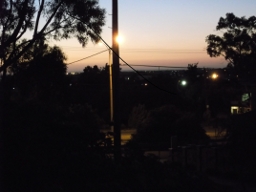
|
Saturday 17 December
I got up and sat down to write out the proof of the theorem, got stuck, took
a shower, tried again, got stuck, prowled around the flat a bit, and suddenly
all was clear to me. I had been doing induction on the wrong parameter. So
I wrote the proof straight down. The theorem says that the number of
subsquares of order 2d of a Latin square of of order n
is at most
n2(n−1)(n−2)(n−4)...(n−2d-1)/22d(2d−1)(2d−2)(2d−4)...(2d-2d-1);
equality for n>2d implies that the Latin square
is the Cayley table of an
elementary abelian 2-group (so that n is itself a power of 2).
I had been debating with myself what to do today. I could make an early start
and have a walk in the Dandenong Forest, and be back in time to change before
Graham picks me up to take me to Jacinta's for dinner. On the other hand, I
have to do my laundry, and Ian Wanless has half promised an outing tomorrow.
Also, there is a huge amount of work stuff piled up. I am a bit reluctant to
do it in Mannix, because the wireless is a bit unstable; and I have had no
time to do it in my office, because there is always another meeting with one
or other of the groups I am working with. In fact, the decision was made for
me.
I went to breakfast, but the room was in darkness and the door locked. So
I went back to my room, typed out the proof, and went down to try breakfast
again. As I shut the door, I realised I had locked my keys inside.
I went downstairs. The door to the West block was still locked from the
outside, so once I went out I couldn't get back in. The breakfast room was
still locked and in darkness. And I couldn't get into the lobby to phone the
housekeeper, since this door is permanently locked on both sides, and there
was nobody else around.
So I went out the side gate through the rosemary garden (it is just a push
button to get out), and in through the front door, and phoned the housekeeper.
She (the duty housekeeper, not the one I had dealt with before) came in a
few minutes, opened the breakfast room and put some things out (there was
already one more customer by then), and let me into my room.
So I picked up my keys and had breakfast. By this time it was well after 9,
so I decided to stick to plan B. I went back to my room, sorted my laundry
and put it on, and then sent a copy of my proof to Ian.
Then I tried to get on with some work emails. Unfortunately the wireless
connection was being particularly recalcitrant. I read my email, which
included one from Rosemary on the joys of retirement. When I took a break
and went down to Dooley's Bar to have a burger and a pint of beer for my
lunch, I started thinking about that, and got thoroughly depressed. Why
are our bosses making it such an uncongenial place to work? Are they just
stupid, or are they really trying to get rid of me?
When I came back, I tried to upload some references to various websites.
It was terribly slow, and the websites were stupid in incongruous ways:
one admitted the existence of a country called United Kingdom, one thought
that England was a country, and one admitted no countries at all but insisted
on a two-letter abbreviation for a state. They were also inconsistent in
various ways about how things worked. Four references took me an hour and
a quarter and didn't improve my temper.
After that I needed a break so I sat on the sofa and read for a bit. When I
tried again, the signal was so poor that there was no point even attempting
to connect. So I took another break and tried again with the same result.
I did manage to save one of Shahn's documents and found it a
badly-produced and inaccurate description of what we do – how can the
Director of Pure Mathematics be so ill-informed? – referring to the
"Algebra and Combinatorics Group" and the "Centre for Discrete Mathematics"
by acronyms.
I decided I had had enough and put the machine away, took a shower, and got
ready to go out to dinner with Jacinta.
Graham arrived a bit early; fortunately I was already there. He'd brought
Ruth, his teenage daughter Xanthe, and the 2-year-old Geneveive.
During the evening I was quite surprised how well Xanthe, and
Jacinta and Marcus' two teenagers Reuben and Natasha, got on, not only with
one another, but also with their parents; not a trace of the embarrassment
teenagers often show in this kind of situation.
It was quite a long drive, first north through the suburbs, then west on an
eight-lane motorway, then more north and west through suburbs, The area where
Jacinta lives has a completely different atmosphere from Clayton. Everything
here is new, but around Jacinta's place there are many old weatherboard
houses with verandahs, and the kind of corner shops that existed in Brisbane
when I was a student. Jacinta's house itself is old weatherboard in front,
and the front rooms are cramped living rooms (opened out a bit), but the
back is completely re-built to create a wonderful kitchen and dining area,
with strange angles and slits through which natural light comes in; a
walk-in larder (Jacinta says this is the only place where her control-freak
tendencies are given free rein), and a vast cooking area including
"his-and-hers ovens". It was Marcus who made the dinner, in fact: Thai-inspired
and extremely delicious.
It was very good to catch up with Jacinta, though there was not much talk
about old times (she had been almost an exact contemporary of Graham at
Oxford). After a succession of different jobs, she is now registered with an
agency which (after a year or so) understands what she wants from a job. So
her present job, with a company that does logistics for the drinks industry,
is very interesting, but if she succeeds in what she sets out to do, the
company will be able to replace her with someone much less skilled (and so
cheaper). She still does voluntary work for the Breastfeeding Association
(basically, sorting out their website, with a team of people with varied
skills).
At the end of the evening, when Genevieve had been put down to sleep but
clearly wasn't sleeping, the talk got onto Marcus' hobby of collecting
pianola rolls, so we had to have a demonstration of a pianola. I hadn't
realised that it is not purely mechanical; you have to pedal to create the
motive power, and the way you pedal has a big influence on how the music
sounds. The final result was that Xanthe fell in love with the pianola.
Her grandmother has one which is not currently in working order, so Xanthe's
mission now is to get her grandmother to get it repaired (there is, apparently,
one person in St Kilda who can do this) and then start acquiring her own
collection of pianola rolls.
So it was rather late when we left and even later when I got to bed.
Sunday 18 December
Hester's birthday: I sent her an email (it wasn't yet her birthday, her
time, when I sent it).
Breakfast was open at 8 this morning, the regular woman who looks after
things was there. She apologised that it wasn't very exciting; I said I
didn't need excitement at that time of day. Anyway, I was out at the bus
stop by ten to nine.
It took me more than two and a half hours to get to Belgrave; this included
an hour spent waiting for buses and trains. I had not chosen my start time
well. But I did figure out that from Richmond I needed to take the Lilydale
train and change at Ringwood; there was no delay with the connecting train.
As often happens, we passed through an incongruous list of placenames from
south-east England – Camberwell, Canterbury, Chatham, Surrey Hills
– interspersed with a few aboriginal names.
As we got further out in the suburbs, the houses became less dense, with
more bush between, and there were occasional views showing that we really
were approaching the mountains. After Ringwood, the line began climbing
fairly steeply, and became single-track after a while. Finally we arrived
at Belgrave. I checked the times of trains back; they are more frequent
in the afternoon, so I didn't have to aim for a particular train.
|
I followed the line to the Puffing Billy station. Puffing Billy was obviously
out on a trip, but there was a line of carriages being readied for travellers
who were going to eat on the journey, presumably rather well. The road
crossed the line at a level crossing, where there were a couple of diesel
engines and some less good carriages, and then climbed steeply up through
a rather posh suburb. Finally I went through a gate into the forest.
|
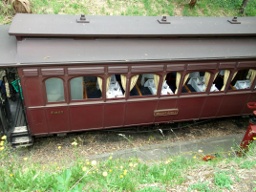
|
|
I had a photocopied page from the Melbourne street directory from Keith
Edwards; it didn't show a scale, and I didn't have much idea. I thought
I would walk along the Cole's Ridge trail (an old road) to Grant's picnic
ground, where the conference excursion had stopped, to get an idea of the
distances. There were very few people (a couple of joggers and a woman with
headphones) near the start, but nobody for the rest of this stretch. Soon
the mountain ash trees started, and the understorey was almost entirely tree
ferns; the air was full of lovely birdsong.
|
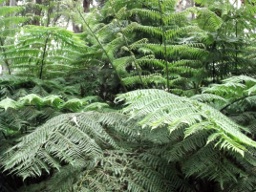
|
|
Soon after, there was the roar of traffic on the road, and the raucus squawk
of cockatoos demanding to be fed by the visitors, so I knew I was nearing
Grant's. I got there in just over half an hour, including a short detour. So
clearly I wasn't going to be limited by time. I had hoped they might have
sandwiches, but there was a cafe doing sit-down meals, and apart from that
only tourist tat. So I got a bottle of water and a chocolate bar, and
continued on my way.
|
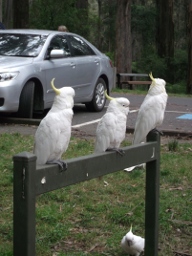
|
Across the road, the path went up quite steeply and was a bit rough. But soon
enough I came to O'Donohue picnic ground, where I sat down to eat my lunch.
I continued on. I had been scanning the ground all around (especially the
downhill side) for lyrebirds, and seen nothing, so I had decided that if I
wasn't fated to see one then that was that. So I was walking along wrapped in
my own thoughts, when there on the path in front of me was a lyrebird. It
stepped daintily over the ferns and ran away into the bush.
Other birds (unidentified) from this stretch were: a little brown bird of the
tree-creeper kind, darker on top than underneath, running sure-footedly on
a sheer vertical tree-trunk; and a wren-like bird, lightish brown with a
broad orange stripe on its back, holding its tail up like a wren but
fanning it out. (Seen from behind the center of the tail fan was the same
orange-red as the back stripe.)
I came to a road, and found that I had missed my way and was somewhere
different from where I had planned. (The map was not entirely accurate and
didn't label the trails.) Across the road were the Alfred Nicholas Gardens.
Alfred Nicholas was not the first to invent aspirin, but since the first had
been a German, he managed to patent it during the First World War, and made
a lot of money, which he spent landscaping this garden, with the help of a
gardener from Kew. It was on the edge of a very steep-sided valley. I went
in, but found that the garden didn't excite me too much with the lovely bush
on the other side of the road, so I didn't stay long.
|
I went back down the trail I had come up on, and found that the trail I had
meant to take was closed, so I couldn't have done it anyway. I continued on
to the Sherbrooke falls (more very steep rapids than falls, and not a huge
flow of water, but quite pretty). Then across the road (past a building which
from the back looked like an old country pub, but from the front was a posh
restaurant with a dress code), and up a very steep hill (the path was
called the Lipscombe break, and I assume it meant firebreak, since it ran
along the back of some houses, and there was a fairly wide cleared area).
|
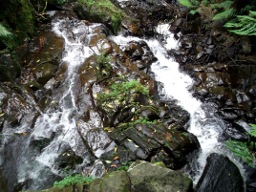
|
|
On the way back down the Cole's Ridge road, I heard Puffing Billy tooting
away, just setting out on another trip. When I got back to the level
crossing, all that remained was the smell of smoke in the air and the
sight of people from the previous trip getting into their cars.
I saw a train pull in and read the sign saying it was leaving in five minutes.
I crossed over the bridge and found some shops, mostly closed. One was a
Subway; a bit reluctantly (they take time since they have to ask you so
many questions about which sort of bread, salad, pickles, etc.) I bought a
ham sandwich, and got back just in time for the train, which was going all
the way to Flinders Street.
|
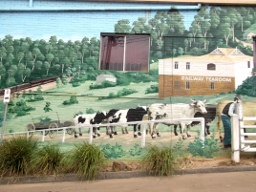
|
The journey back was much quicker. At one point, an unassuming-looking man
sat in the seat behind me. Every now and then he would speak, in an
incongruous deep resonant voice with a pause after each word or phrase,
things like "Can anyone tell me why this train does not appear to be moving?"
or "I regret to say that the signal on the down line is haunted."
I had a quarter of an hour's wait at Richmond, in company of a chatty student,
until the Cranbourne train came. At a certain point I noticed Tony Evans
and Ian Wanless in the same carriage. Ian was getting off at my stop and
walking home, so he stopped at the bus stop with me to talk about the paper.
The bus came in five minutes, and I was back in my room in Mannix before 5.
Time to transfer and gimp some photos and write up my diary before dinner.
Dinner was roast mutton again, tough and sinewy. There was no gravy, but
the roast potato had been joined by roast pumpkin. There was a very dry
lemon pudding to follow.
After dinner, I had to read Ian's draft so as to be up to speed when we meet
up tomorrow. Then I noticed that the old worn-out shorts I bought in Cairns
have a good strong toggle on the side elastic. My new hat has a feeble rubber
apology for a toggle. So I put the toggle onto the hat. (Those shorts might
get thrown away before I come back.) Incidentally, the hat has shrunk a bit
and is now a better fit anyway. After that, I played a game of sudoku and
found my eyelids drooping, so I read a bit and went to bed.
Monday 19 December
My last full day here. If and when I sit down to write tomorrow's diary,
I will be in Queensland.
I woke early after a very good night's sleep. The depression over our
bosses has lifted considerably. In my email to Shahn I had pointed out
that I had no part in the "Centre for Discrete Mathematics", so had no
idea what it was and what it did; and that I didn't think that we had
an "Algebra and combinatorics group", and certainly I have never been
the leader of such a group. It occurred to me that this is true; I may
have had some part in making QM an attractive place to people in this
area, and they have come and done their own thing, but I have never
accepted or wanted any kind of leadership role in this. So I should be
quite happy to stay on doing my own thing, and not acknowledging that
anyone else is my boss and can tell me what research to do. With this
perspective, it all looks less black.
I had my last cup of real coffee here, finishing up the packet that Graham
had given me along with the small cafetiere, and sat on the sofa thinking
about what we have achieved in this visit. We have not made any great
breakthroughs, but have gained a huge number of insights. Small graphs
whose chromatic polynomials have the same splitting field appear to be
very atypical: they have a lot of symmetry, and the "interesting factors"
of their chromatic polynomials have a very strong tendency to be related
by a shift or a reflection rather than by a more complicated transformation
as you might expect. Something is going on!
I went over to the department. After I had worked on various things (including
updating the QM pure maths pages at Shahn's request) for a while, I looked
at my email and found one from Graham saying he was tied up until 2pm.
So I went over to Maths and found Ian. We worked all morning, very
productively. I was able to knock down his conjecture about subsquares of
prime order, and also to show that the maximum number of subsquares isotopic
to a given square L grows slightly faster than quadratically (and we
conjecture that there are some squares where the growth is slower than
cubic). We left it that Ian would do some last-minute changes and then turn
it over to me.
Then we went to the Campus Centre for lunch, after which I returned to IT
where I found a group just leaving for lunch at the other place. I said
I would come along with them, and had some fruit and a coffee. It was
agreed that we would all go out to dinner to say farewell to me.
Daniel was tied up, but I worked with either Kerri or Graham (or even,
occasionally, both) for the rest of the afternoon. We turned up even more
strange behaviour, but found something which might give us a lead. If
two cubics have the same splitting field, then a root of one can be expressed
in terms of a suitable root of the other. This expression is in general
quadratic (though it is linear in almost all our examples); but it can also
be taken to be linear fractional, which looks more tractable.
|
At a bit after 6 I went and packed up stuff in my office and turned the key
over to Graham, since it was too late to return it to the administrator.
Then I went for a walk around campus, thinking about the "slightly faster
than quadratic" result with Ian. It is even easier than I thought, and
a cleaner result as well; I just had the wrong constant this morning.
We went to an Indian restaurant, but they were completely taken aback when
we asked for a table for ten, and said they couldn't manage it. So we went
to the Chinese next door. We had a very good meal, far more than we needed
to eat, and plenty of good humour. Finally, at about 10, Kerri drove me
back to Mannix, to where she will pick me up very early tomorrow morning.
|
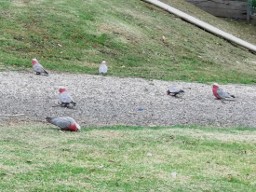
|
Queensland
Tuesday 20 December
As always, I was awake before the alarm went off, and was able to take a
shower and pack without any stress. I went downstairs, found (as I expected)
that the door into the main block was still locked, so I went out through
the rosemary garden and in the front door to drop my keys off, and then
went out to wait for Kerri.
She was right on time. On the way we talked about my visit (which they seem
to regard as a success) and various other things. The road we took, the M1,
is a toll road for part of its length, but drivers don't have to stop or do
anything. So inevitably this passive process is known as being "tolled".
I couldn't resist saying "Ask not for whom the road tolls: it tolls for thee."
Kerri knew the quote and simply said "Just so long as the bell doesn't toll
for me."
The traffic was very light at that time of the
morning, even approaching the airport on a fairly narrow road, so I was there
much too early - indeed, I could have caught the flight before, had I had a
booking on it. There was almost no queue for the bag drop, so after doing
that I went and found a breakfast place. It was called "Tide something",
the slogan being "a tidal wave at every seat", perhaps not such a good idea
given what has happened in the world in the last few years. I had two
eggs benedict and a cup of real coffee: such a welcome change from Mannix
food!
Then I went through security with no fuss, bought a newspaper, and sat down
to do the puzzles while I waited for the flight. The paper was the Melbourne
Age; I did the cryptic crossword with no difficulty and then the sudoku and
a couple of other puzzles. By that time the flight was almost ready to board.
They divided passengers into two groups; those in the front half of the plane
used the airbridge, while those (including me) in the rear half kad to go
down the steps and across the tarmac. (The same thing happened in reverse
in Brisbane.) We were away promptly. I had a window seat, but it was cloudy
and there was not much to see; and refreshments are charged for on this
airline, so I did some more puzzles in the in-flight magazine until we began
our descent.
There were some views of the northern part of the Gold Coast and the southern
part of Moreton Bay including the islands as we came down. We made a sharp
turn just before the final descent so we could see the runway we were about
to land on; it looked impossibly small, but the pilot hit it OK.
Off the plane, my bag came very quickly and I was out. There was a kiosk
selling tickets, but it was unstaffed; a sign directed us outside to the
station. There was an overbridge, almost inaccessible because of building
work, and a very slow-moving queue at the other end, but I made the train
with five minutes to spare.
The first impression was the brightness and clarity of the light. Even the
nice days we had in Melbourne were not like this.
A pleasant journey to Roma Street. I went up to the top floor. The Greyhound
counter was staffed, so I bought a ticket from them; I had nearly an hour
to wait for the coach, so I went down a floor after food. It was mostly
McDonald's, KFC, etc., but there was an independent pizza shop where the
pizza was baked before your eyes, so I had a chicken and pesto pizza and
a bottle of Bundaberg. Then back upstairs, with not long to wait for the
coach.
It was the stopping coach, which suited me fine, since the route is closer
to what I was familiar with when I was a student. Out through the suburbs
of Milton, Auchenflower and Toowong along a road I knew well, with lots
of old Queenslanders needing a lick of paint. Then the freeway, getting
into newer stuff in the western suburbs. Flame trees shone brightly through
the bush and in gardens all along the route.
|
Coming into Ipswich, as well as flame trees, there were frangipani,
bougainvillea, and various other flowering trees, bushes and creepers.
I did notice, however, that though I had seen some silky oaks in flower in
Melbourne, none of them here had flowers.
The coach stopped at the Plainland Hotel, Gatton, Grantham and Helidon.
I thought that Gatton looked remarkably spick and span and prosperous, which
hasn't always been the case in the last few years. Grantham still bore the
scars of the floods: houses missing or destroyed.
I saw an ibis, a heron, and a hawk of some kind.
|
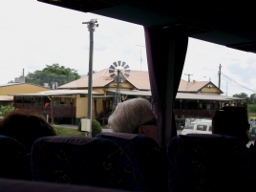
|
Everywhere was amazingly green, and it was new growth coming up through older
grass. The creeks had a lot of water in them: Tenthill and Lockyer Creeks
just the other side of Gatton were flowing strongly, and Lockyer Creek in
Helidon had a fine extensive pool of water. Even Tabletop had a green
tablecloth on.
The bus struggled a bit, and was passed by many big trucks, especially up
the range. The load on one of these trucks consisted of four bus shelters.
We pulled in to the old McCafferty's terminal in Toowoomba, having come down
Herries Street past the Grammar School, and I found a phone and called Marie.
I sat in the sun to wait for her; she came in about ten minutes and was able
to stop in a convenient loading zone to pick me up.
We stopped on the way home for her post, fruit and vegetables (including a
tray of mangoes, and bananas which have been up to $15/km but are now down
to less than $2. Then to the Wyalla Plaza for mince (Marie is cooking a
meat loaf). We exchanged calendars: she has produced a family history calendar,
with some of her own photos, some pictures of ancestors, and some from various
archives. We had a cup of coffee and some gingerbread and Christmas cake.
Marie brought out her bird book, and I looked up the two unidentified birds
from the Dandenongs. One was a treecreeper of some kind (as I had strongly
suspected) - but I am unable to say which kind. The other was a rufous
fantail.
Marie cooked meat loaf for dinner, with potatoes, beans and corn, and then
mango and ice cream. We watched the news, and then a programme where some
grumpy people explained why they hate Christmas. Then it was bedtime, so I
took a shower and went to bed.
Wednesday 21 December
Breakfast was almost indistinguishable from what I used to get in Mannix:
meusli, toast and vegemite or honey, and instant coffee.
After breakfast, I showed Marie some family photos and the pictures from
Victoria. Then she went off to buy cat food, and I tried without success
to connect to her wireless network. I have the password from last time,
which she swears she hasn't changed, but the system won't accept it. I
will just have to be incommunicado for a while, I guess. Instead
I got on with typing up one of the proofs to go in the paper with Ian
until she got back.
|
We had cold meat loaf and salad for lunch, and soon after set off on a drive,
north out of Toowoomba on the Crows Nest road. First stop was at a little
shop run by a friend of Marie's, selling lovely but not cheap stuff mostly
imported from Provence but some made by local craftsmen. The woman is French;
according to Marie they lived in Algeria before independence, and found
France too cold, so chose to come to Australia knowing only that it was
warmer than France and had kangaroos; they ended up in a beautiful spot
outside Toowoomba. Marie always speaks Frence to her when she is there,
but the woman (whose name I didn't catch) is very rusty in her native
language now. I did buy a soap dish as a Christmas present for Helen.
|
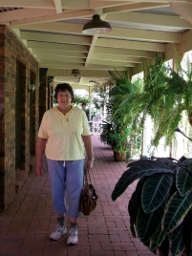
|
Then we continued on our way and turned off for the Perseverance Dam.
Marie hadn't been to these dams for many years, since they have been
so empty (down to something like 7% of capacity) until the floods a year
ago; now they are full. We drove over the Perseverance Dam wall and parked
in a little picnic spot near the spillway, where we walked across the
spillway. The dam was at virtually 100% of capacity; wind-driven ripples
were splashing over the spillway. Below were tree trunks washed down by
the flood which haven't been cleared away.
|
We drove on. On the Wilson's Promontory trip, since koalas were promised,
I spent a lot of time scanning the trees looking for them, without
success. By force of habit I had done this on the start of this drive,
but by this point I had decided not to bother. But it was like the lyrebird
all over again. Marie was telling me a shaggy dog story about a fight
between a crow and a goanna, when I looked up and saw a koala in the fork
of a tree right next to the road.
Marie stopped the car. The koala was woken by this, and pricked up its
ears to look at us, and very soon started climbing (remarkably quickly,
as they do) up a tall straight branch into the leaves, where it could eat
and not be seen. I managed a couple of pictures, which don't show much
but may be OK to be cropped and blown up.
|
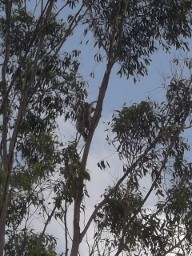
|
|
The sign at the turn-off for Cresswell dam said that there was a $2.50
entrance fee. We drove down the road, and when we found the pay barrier,
we saw that they had put a convenient small parking space; so we stopped
the car and walked down. On the way, we passed a couple of plovers on a
hillock, studiously avoiding each other.
There is a nicely landscaped area by the water, with picnic tables and
barbecues, a beach volleyball court, shelter from the rain, toilets, etc.
We wandered round, seeing several pale-headed rosellas, and a large bird
of prey which might have been some kind of kite, and then started back.
I was admiring the greenness of everything when I noticed, just on the other
side of a belt of trees, several grey kangaroos. I tried to take a photo
through the gaps in the trees, not sure how successfully.
|
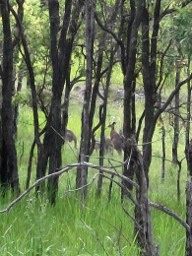
|
We got back to the car and set off. Rounding a bend, we saw a pretty-faced
wallaby on the road just in front of us; Marie nearly skittled it. By the
time we had stopped, it had leapt away into the scrub. Still, not a bad
haul of wildlife for a trip!
|
So we drove on to Ravensbourne, parked at the first picnic area, and walked
the rain-forest circuit. We covered ourselves in insect repellent before
setting off, as Marie thought there might be ticks. She didn't seem to have
heard of Lyme disease, though I am sure that Liz Billington said she caught
it from a tick somewhere in south-east Queensland. In the event, we didn't
get a tick, but there was a leech crawling up Marie's shoe when we got out
of the park.
It was remarkably dry underfoot, and there was no flow in any of the small
creeks. I assume that the rain which Toowoomba got had missed Ravensbourne.
The whip-birds were singing vigorously, and there were some nice palm trees
and some splendid specimens of Sydney blue-gum, one identified by an ancient
tin label. The path had quite a bit of up and down, including some fairly
steep steps; I was pleased to see that Marie was having no trouble with the
uphill stretches and steps.
|
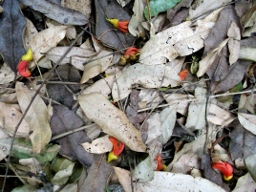
|
Then we drove on further to the lookout. There is a gadget for showing what
you are looking at (I forget the name). We managed to identify Flinders Peak,
a faint blur on the horizon in the direction indicated; but Mt Barney and
Cunningham's Gap were totally hidden in cloud and murk.
So we drove home, where we had coffee and Christmas cake, and then I mowed
the lawn while Marie cooked dinner. It was tinned tuna fish; her main meals
are not great, but they have lots of fresh vegetables with them, and then
delicious mango and ice cream to follow.
After dinner, Marie decided to phone Chris. Many people in our family can
talk the hind leg off an old iron pot (to mix metaphors a bit), but Chris
can even stop Marie from getting a word in edgeways. They talked until the
batteries on their phones were nearly flat, and then Marie passed the phone
over to me, and we talked until the batteries were really flat and the
phones were beginning to cut out. I enjoyed the conversation, and I think
Chris did too. Things are very much better for him in the last few years;
he has a job which is not ideal but at least he enjoys doing; his two
married daughters live quite close to him in Ayr; and he is still scheming
about the future (a visit to Scotland? go fossicking for gold in Charters
Towers? etc.)
While Marie and Chris were talking, I had put my photos on the computer and
Gimped them. I was delighted to see that, unlike my last camera, this one
makes images which can take considerable blowing up. So I have a couple of
tolerably good pictures of a koala and one of several kangaroos playing
hide-and-seek behind the trees, rather than just faint blurs in the distance.
After that we washed the dishes; Marie went to have a shower but I decided
to leave mine until the morning and went off to bed.
Thursday 22 December
I got up and had a shower before breakfast of a boiled egg.
After breakfast we set off first for ICR, Marie's internet service provider,
to try to see why I couldn't connect to her wireless. It turned out that
the password was different from the one I had copied down from last time.
|
Then to Downs Steam. This is a railway enthusiasts' group with plans which
British railway enthusiasts could only dream of. In September they hope to
be running steam trains between Drayton and Stanthorpe on what used to be
the Brisbane to Sydney main line! The rate at which things get done there
seems extraordinary. They were pouring the last concrete for the floor of
a new engine shed which had not even been started last time Marie was there
in September; they were taking delivery of a truckload of old ironbark-wood
sleepers donated by Queensland Railways, which will support the track
connecting their platforms and sheds to the main line; they have a restored
turntable which looks as good as new; and they have several carriages which
were new when I was a student in the 1960s.
|
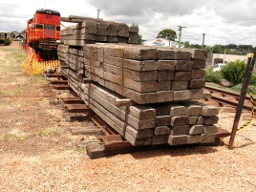
|
|
Marie knew the man who runs the
place, formerly a successful businessman (Marie knows everybody); he was
giving two mothers and small children a tour, and along with keeping the
children from falling onto the railway line, doing some entirely unrelated
business (they employ youths from the Westbrook Correctional Centre, from
which in time past Aughamore used to get workers, and the boss of the place
had come to talk about the report on the scheme; he had been waylaid by one
of the volunteers who has some mental problem...), and so on, he managed to
show us lots of other things, including a carriage which is being converted
into a museum, the office, the staff canteen in an old Melbourne tram, and
the dining room which was being readied for a very posh 60th wedding
anniversary dinner for 24 people. I was tremendously impressed with the
whole enterprise, and would like nothing better than to come back when
the trains are running and take a train to Stanthorpe...
|
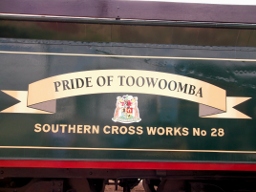
|
Anyway, time passed, and we had to leave to pick Helen up to take her to
lunch in the RSL club in Oakey. On the way out, Marie drew my attention to
Westbrook Creek, which a few years ago had been choked with silt and weeds;
the floods have cleared it out, and now it has a good flow of water in it.
Early reports of explorers on the Darling Downs speak of the pleasant
streams everywhere; I suspect that what has done most to destroy the flow
in these streams is topsoil washed from ploughed land.
Helen has got rid of the old 4×4 and has bought on impulse
another car which Marie says has various mechanical problems, including a
short which flattens the battery and which nobody can discover.
We arrived and bundled into the car. It seemed to go all right, but it
was a bit smelly (and I don't usually notice such things!)
Anyway, we got to Oakey and went into the RSL club. It was very crowded,
being the oldies' day out. We ordered food (we all had barramundi in a
macadamia crust) and wine (a bottle of Oyster Bay sauvignon blanc). The
food took a while to come, but the portions were very large when it came,
and I got to finish Helen's fish as well as my own.
After that and some business (supermarket, bank) we drove back. Everywhere
Helen (who is considerably more frail) absolutely refused to have anyone
help her, or to use the ramp rather than the stairs. Marie is a bit worried
about her; I think that though she is physically frail, she is mentally OK
except for the family failing of telling the same story several times.
|
After a cup of coffee, Marie went off to ride her horse, and I went for a
short walk. I headed south to Wallaby Hill, this being the direction I am
least familiar with. The sky was very cloudy and rain threatened, but it all
passed around well to the north. There was nothing especial to see: there
were large numbers of galahs but they were mostly hiding in the trees; I
saw some kind of waterfowl fly over; and there were rosellas, peewees,
magpies, and of course tickeaters. There were a few wildflowers, including
late wattle, and a nice view from the top of the hill.
I walked back and chatted some more with Helen until Marie got back. Helen
had been sorting some of Betty's things; among them was a small object which
seems to be a seal stamp. The inscription was hard to read, but when Helen
produced a mirror, I was able to decode it: "It guides me well". It sounds
like some kind of family motto, but a Google search later didn't turn up
anything of much interest.
|
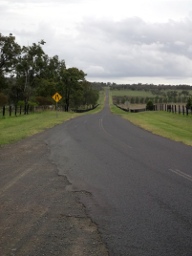
|
Then we drove home. We were not in the least hungy and I suggested just having
mango, to which Marie agreed. After watching the news, I tried out the new
password, and it worked; so I am back in communication with the world.
Then we had a go at Marie's web pages. I found I had copies in London which
I could download onto her computer. But there was a problem uploading them
to the ICR pages; they have reorganised their systems and no longer have an
FTP server, so my old instructions were no good. I tried using scp, with
a bit of guesswork as to where to copy the files to. Nothing worked, partly
because the passwords Marie typed in were not accepted. We will have to go
back to ICR, maybe tomorrow. Marie also showed me her private literary blog,
which is not working either: she typed in a poem a year ago and it came out
with each line in a separate box; and the people she invited to join had
been unable to do so for technical reasons. I have no idea what the problem
is there.
In the meantime I transferred today's photos and made a start on gimping them.
But all to soon it was time to help with the dishes, take a shower, and go
to bed.
Friday 23 December
Marie phoned ICR after breakfast to try to sort out the problems with
uploading to their website. They couldn't help but said would try to have
an answer this afternoon. So we were able to set off fairly early.
|
First to the Toowoomba Grammar School, where Marie had arranged that Ellen
Morosini would give us an individual tour of the new museum. (As I said,
Marie knows everyone.) It was quite interesting, though I had seen copies
of a lot of the stuff in the books they keep sending me. But in the section
on my era, they had a photo of someone I was at school with (Buri Kidu, who
became Chief Justice of Papua New Guinea). I told some stories about the
two headmasters during my time there, "Pud" Heenan and "Sad Sack" Olsen,
which they had not heard before.
The school is looking extremely prosperous, I have to say, as indeed are
all the Toowoomba schools. It has a new aquatic centre, which I had seen
from the bus; but later we saw that Marie's old school, Fairholme, also
has a new aquatic centre.
|
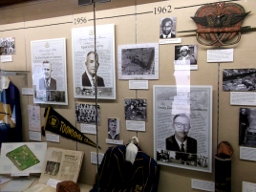
|
|
Marie dropped me at the end of Bridge Street; we had agreed that I would go
for a walk while she went to have coffee with her friend. I walked in
Jubilee Park, the one in which the trails seemed least affected by the floods;
all the main trails were open, and only a couple of side trails closed. This
park is on the opposite side of the quarry from Prince Henry's Drive, and I
had never been there before, so I suspect it was only created fairly recently,
though there is an old track, and a clearing where there was a camp for
unemployed families during the Depression.
What I hadn't allowed for was that the map didn't have contour lines, so I
didn't realise that basically the tracks just went down to the bottom of
the range. So I had an easyish walk out, and a quite demanding walk back,
and was ten minutes late meeting Marie afterwards. Unlike most places, the
ground was bone dry and cracking, though there was flow in some of the
little creeks coming down the mountain.
|
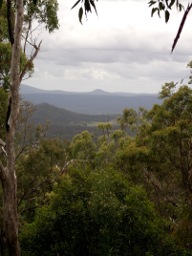
|
|
There were many nice flowers, both wild and garden escapes, including some
stunning blue morning glories, which I tried to capture in a picture (the
Fuji did quite well). Lots of birdcalls, including whip-birds, currawongs,
and kookaburras (one group of koonaburras near me broke into a full-throated
laugh, unlike most I've heard which start warming up and then decide that
it wasn't all that funny), but I didn't see many birds; a few rosellas, a
kookaburra, and some brown birds a bit like wattlebirds or cuckoos but
slightly larger and with a reddish tinge to their brown.
Marie drove me home drenched in sweat, stopping for a couple of errands on
the way. I had a shower while she brought the shopping in, and then we had
lunch. Cold meat loaf and fresh salad (including an apple cucumber from Helen)
made a perfectly adequate meal.
|
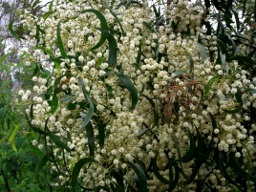
|
After lunch Marie phoned ICR, and also her garage (the car has started making
some ominous clunks when it starts off). The car is booked in for early
tomorrow morning. ICR hadn't done anything, but promised to have it by later
in the afternoon. So we sat down to watch an extremely good ABC documentary
(on video) about the 2010 filling of Lake Eyre. Beautiful colours and images.
The end was a little poignant, since the person doing the commentary, along
with several of the crew, were killed in a helicopter crash shortly afterwards;
also they ended with something about how nobody knows when the next flood
will be, unaware that it would be in 2011.
After a while, ICR phoned back, to say there had been a problem with the ftp
which would be fixed shortly. We washed the dishes, and then tried, and it
was all working fine. So we uploaded the "new" web pages (which I had written
for her in 2009), checked it all worked, and then made a few small changes
(hopefully part of the process of demystifying things for Marie) and checked
that they worked. Marie was very pleased with the result.
The link on my page had been broken since ICR had changed
the www in their address to w3 at some point; Marie claims that she told me,
and even seemed very slightly aggrieved that I hadn't instantly updated it.
But soon everything was fine, and we watched the rest of the documentary,
until it was time to go out for dinner.
|
We went to Marie's favourite Thai restaurant, Dee's Vintage Thai:
unpretentious decor, plain
but tasty food and lots of it. The meat was beautifully tender, and the
vegetables beautifully firm. We had a mixed platter for starters, and
then Marie had what she always has, duck in ginger, and I went for
Massaman (since the plan was that we would share, and so I couldn't
have anything too spicy). But we didn't manage to finish, and had to
leave quite a bit of food. Never mind, most enjoyable.
Then we went for a drive to see the Christmas lights. Not how I would
have chosen to spend an evening, but Marie was keen, and I know how to
behave. After seeing the first set of lights, we were driving back near
Queen's Park; cars were parked in every available space, but just as we
were approaching, someone conveniently left. So we were fated to go in
and see them. What a crush of people! We went on to visit some of the
prizewinning lights, and also a street near Marie which didn't win
anything but was at least as good as several who did.
Then back home, for mango and ice cream for pudding, and off to bed.
|
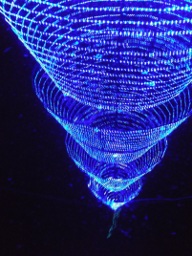
|
Saturday 24 December
Marie had to get up early to take her car to the garage and walk home. After
breakfast, I worked on the paper with Ian Wanless until Marie got home. It
is making progress but still quite a bit to do; but I am just too busy
at the moment!
When Marie got home I went to the shops in Wyalla Plaza. I thought I should
get something for John and Jenny even though it will be after Christmas.
Marie suggested licorice for John, which I wouldn't have thought of, but
fortunately it was one of the few sweets the newsagent had. I also got a
copy of the weekend Australian for the puzzles. From the chemist I got
some soap and hand cream.
We settled down to do the prize crossword, which claims to be from the
Sunday Times but clearly has been tweaked, since there were too many
Australian references, including ringer for someone who is champion at
something, and isis which apparently is a place in Tasmania. We finished
the whole thing before lunch.
We had lunch and then the big job of the day; manoevring Marie's huge and
heavy old television into the back of the car to take to the dump, or
"Waste Management Centre" as it is called now, much to Marie's scorn.
It was quite heavy, but fortunately involved no stretching. The dump, which
used to be on the south side of town, is now far out to the north beyond the
end of Greenwattle Street, and we had a bit of trouble since Tor Street was
closed just before the end (maybe because of flood damage) and we had to
turn back.
|
It was a bit confusing at first but actually very easy. You drive up onto
the weighbridge, and declare your cargo. They take your money and give you
a ticket and directions. The television, a bit to my surprise, counted as
general waste, so we went over to where you could back in to a bay and tip
the stuff into the waiting bins. Marie's television was so solid that it
didn't break, but it shattered to pieces another less solid television that
it fell on.
A storm was in the air, but we decided to do a couple of parks on the outing.
We went to Newtown Park to see the state rose garden; there were four
plovers, several magpies, and many galahs, and a couple of rosellas flew
close to our heads like cruise missiles. The roses were not at their best,
some bushes having no blooms at all.
|
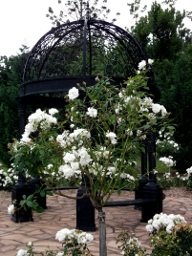
|
|
Laurel Bank park is a lovely park, with its scented garden, wisteria arbour
(not in bloom, of course), etc. They have made Thomas the Tank Engine in
topiary, with park benches in the carriages for passengers to sit. I'll
send the picture I took to Lex and Logan if I get round to it. Also lovely
waterlilies in a pond, and a bright yellow tree against the dark clouds.
The rain held off, all but a few spatters; once again the clouds went around
to the north.
|
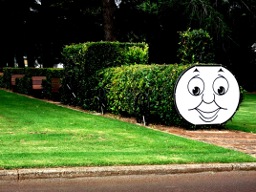
|
We came home and did the Times crossword in the Australian, all but one clue:
"She is last to see monitor, way off", E_I_A. Then Marie cooked dinner,
very nice pork shoulder chops marinaded in soy sauce and ginger, with
lots of vegetables.
After dinner we watched the news, had mango and ice-cream, washed the
dishes, did a few more modifications to Marie's web pages, and then did
the quiz in the Australian, getting far from full marks but probably enough
to pass. I could tell her what group Hank Marvin was in, and she could tell
me who was the Australian cricket coach prior to the present one.
We had a bit of an argument about Latin, and then I left her composing an
email in French and went off to bed.
Sunday 25 December
We had to make an early start, so we were up and off after a quick breakfast.
But, when we were almost out of the Toowoomba outskirts, Marie suddenly
remembered that she had left her handbag behind, so we had to turn round
to get it. Now Marie can drive cautiously, as she did yesterday with a
huge television set rattling round in the back; but now it was rally driving,
over the edges of roundabouts, and I didn't feel entirely happy.
We arrived at church about five minutes late, and the service had already
started. The current Oakey rector is a woman, and did a rather good job.
I didn't entirely like the small rants against political correctness, and
I would have liked to argue back on some things; but she made some good
points. For example, Mary was 14 or 15 when Jesus was born, and Joseph only
a few years older; they had nobody to help or support them, so it must have
been quite a terrifying experience for them.
Marie and Sue Batzloff sang a couple of duets, not too badly, although Sue's
voice was not in good working order.
|
Afterwards I talked for a while to John and David Batzloff, mainly about
retirement, grandchildren, and such things. Then I set out to walk back
to Helen's while Marie drove, so as to go for a ride before lunch.
On the way, a magpie and many other birds sang, there was a peal of laughter
from a couple of kookaburras, and I saw an old friend, a willy wagtail.
There were some quite large mushrooms growing in the gravel on the road
verge; I might have expected them to be in the grass instead.
I thought about the ellipse argument to finish off a proof in
the paper with Ian Wanless, and found a much better way to do it.
|
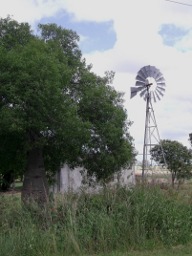
|
When I got there, Helen provided sherry and Christmas cake; Marie hadn't got
going yet, but did so straight afterwards, while I gave Helen an occasional
hand getting the lunch ready.
When Marie got back and groomed Faith, it was just about lunchtime. Cold
chicken, a ham (very nice!), potatoes, lettuce, tomato, cucumber, and tinned
peas, corn, and asparagus, with fizzy wine to drink. We ate somewhat
immoderately. Then there was Christmas pudding and custard.
After dinner, I sat in a chair, and my eyes did close for a bit. Marie and
Helen also stretched out on chair and sofa, but before they napped, they
suggested that I had a go on a jigsaw puzzle they were stuck on. So I did
that while they slept. They hadn't got very far, but almost half of the
joins they had made were wrong, so I had to do a lot of disassembly before
I could start. I finished the outside, and made some start on the middle,
before getting bored with it.
Then it was time for tea and more Christmas cake, and then time to go, after
Marie and Helen almost came to blows over who would have the lettuce: Helen
can't eat lettuce, and Marie claimed to have one already, but took most of
it in the end.
Driving home, the clouds that had hung round for several days had cleared
away, and the evening light made everything look splendid, especially the
leaves on the gum trees. Gowrie Mountain was in bright sunlight, while the
ridge behind it was still in shadow. Most impressive.
Back home, we watched the news (and the Queen) before dinner for a change.
Marie can't have a meal without protein and carbohydrate, so she made toasted
cheese, while I just had lettuce and cucumber. There was a film of a Noel
Coward play on television, which Marie claimed to watch, though she really
did her email instead; I wrote my diary, read my email (there were some
lovely pictures from Neill, who also quoted Logan's response to the
picture I sent: first, it's not Thomas, it's Percy, since it is green;
second, he has to go to Australia to sit on the seats!), and wrote up the
proof I had invented earlier. By the time I had done this, compiled it,
and sent it off to Ian, I thought I had done a day's work, so I just
transferred the day's photos.
My shoulder had hurt a bit during the day, so I took a shower and then
rubbed emu oil in.
After I had showered, Marie called me out to see the stars, which even
in the city were very impressive, especially Jupiter and another bright
reddish one which appeared not to twinkle, which we thought may have
been Mars, though I have an idea that Mars is a morning planet at present.
Monday 26 December
I'd decided that I would go to Wyalla Plaza and do a load of laundry after
breakfast. Marie was interested in having some more practice at the Times
crossword, so I agreed to buy an Australian while I was there. It would
have the answer to Saturday's puzzle, so I put my mind on the one clue we
hadn't got, and it came very easily: ELIZA.
It was a glorious day, completely cloudless, warm but not hot, and with the
barest trace of breeze.
The wash cycle in the laundromat in Wyalla Plaza is quite quick, just 25
minutes, so I only had time to do the hard Sudoku and start the easy one
(which was actually harder than the hard one) before it was finished. I came
home and pegged the washing up on Marie's line. Reaching up above my head
with both hands – this is something I couldn't have done until very
recently. I was thinking earlier that in two weeks' time I will be lecturing,
and will have to write on the board; but it looks as if this should not be a
problem.
We tackled the crossword, and by lunchtime had finished it, though there
were three clues where we couldn't justify our answers. But I kept them in
the back of my mind and worried away at them, and by the end of lunchtime
had justified all three. Some of the clueing in this crossword was far more
intricate than I am used to with the Guardian compilers, who are fairer to
their puzzlers. At the same time, Marie watched the start of the Boxing Day
test match and the start of the Sydney to Hobart yacht race.
For lunch, we had Helen's ham and salad, and bread fresh from the freezer.
Then I took my washing in (already almost bone dry) and dried the dishes.
|
After lunch Marie suggested that we go to the pictures to see "Iron Lady"
which opened today, and then go for a walk in Queens Park. She got there
early, worried that there might be a long queue, but in fact the town centre
was almost deserted and there was almost no queue at all. So we had to sit
through ten minutes of Sixties pop music before the advertisements started.
It was an incredible movie. Told in flashbacks in the mind of the demented
old ex-prime-minister, it took the audience a little while to realise that
the Dennis she kept talking to was simply one of her hallucinations. The
flashbacks, not following a linear sequence, kept us on our toes, and gave
the whole thing an incredible richness. Meryl Streep was absolutely brilliant,
no doubt about it. And the supporting cast were spookily like the politicians
and other public figures they played, especially Michael Foot, I thought,
but Michael Heseltine, Geoffrey Howe, et al. were all very close to their
models.
|
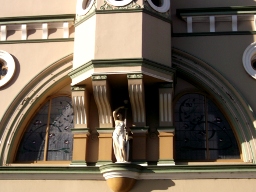
|
|
After that, we walked into town to get some cash, and then walked up to
Queens Park. The lights were being dismantled, but Marie took me to see a
few things I wasn't aware of: a group of windmills (mostly Southern Cross
from the Toowoomba foundry) outside the Cobb & Co museum; a Wollemi pine
(the most recent araucaria to be discovered, only in the 1990s, in a
ravine in the Blue Mountains whose location is still a closely-guarded
secret), and a memorial to a local suffragette, who had a strong influence
on the successful votes-for-women campaign at the start of the 20th century.
The park looked absolutely lovely in the slanting sunlight. A kookaburra
flew to a branch just above our heads and laughed.
|
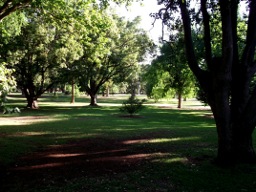
|
On the way, my camera told me that the batteries were flat. By taking
pictures very quickly and turning it off straight away, I managed to get
a couple of pictures. When we got home I changed the batteries, then
transferred and gimped the three photos I did get, and backed everything
up, this being a convenient point to do that since there may not be any
more Toowoomba photos.
After dinner we did some more work on Marie's website. I helped her to
download a copy of everything so that she has it on her computer in case
the ICR machines crash. Then I wrote a short blog post entitled "Slowest
web designer?" which might attract some traffic to Marie's site. Her web
counter seems to advance only by one a day; I suspect that the counter
software does this to stop people artificially inflating their counts
by frequently accessing their own pages.
Marie emailed the guy who runs the observatory in Maidenwell. It turns out
he is doing a session tomorrow night, so she booked us in.
Tuesday 27 December
Before breakfast, I read through Graham's notes on the research we did
earlier this month. This gives me a couple of things to think about.
I will probably have to look at my own data for some of these.
Marie did her laundry and then put the cricket on. I sat down to reply to
Graham giving some more information on splitting-field equivalence. Then
Marie decided to update one of her web pages. It wasn't totally
straightforward, partly because the text editor on the Mac has as its
default that it opens an html file as html rather than plain text, and
partly because she hadn't really thought what she wanted to do. But
eventually the job was done.
Marie was delighted about two things: first, her page has had 57 hits since
she put the web counter on it; and second, she so enjoyed the "mget *"
command we used yesterday, and was even more delighted to find that she
was enthusing about using Unix commands. She will get lots of Brownie points
with her Mac user group!
We had lunch and then there were a couple of hours until time to set off.
I packed and then should have sat and chilled out, but I have been on the
go for so long that chilling out was impossible. A last scan of my email
(I probably won't see any for a week or more) revealed one from a postdoc
asking for a reference, required by early January. So I frantically did that.
|
Finally we were off. It was a lovely afternoon, the morning clouds had
partially cleared and there were big tumbled cumulus. As we went out
through Oakey, some of the cumulus darkened and there were showers visible
in various directions. The view of the northern Downs after Oakey was as
lovely as I have ever seen it: bright red cultivated earth, bright green
crops, dark green or grey of trees, blue sky, clouds every shade of grey
from white to black. The only blot on the landscape was the huge open-cast
coal mine threatening to engulf Acland. (There was no working when we passed,
and I didn't get a picture; this one is from Friends of Felton, fighting
to prevent a similar disaster happening there.)
|
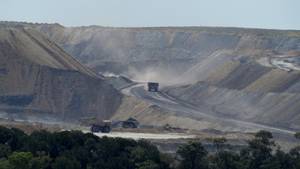
|
Down through Cooyar, very different country, much poorer, no cultivation,
but sandstone, ants' nests and prickly pear beneath the gum trees. Showers
continued to be visible on all sides, cars coming the other way had their
headlights on, and the road was wet, but we didn't see a single splash of
rain. By the time we had arrived in Maidenwell, it was fairly clear that
all the showers and storms had missed us.
|
We went into the pub, where they didn't seem to have much of a clue about
us. They showed us two rooms, one with two single beds and a key in the
door, one with a double bed and no key. I took the two singles, thinking
Marie would be more comfortable in a bigger bed and further from the
possibly noisy bar.
We went over the road to the Trading Post for coffee and excellent carrot
cake. There was a sign to the Coomba Falls, 2km, so I said I would walk there
while Marie went back to the hotel.
|
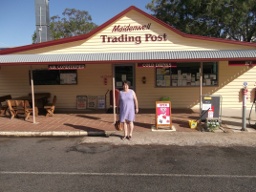
|
|
I started off down the road. Magpies and crickets sang, kookaburras laughed,
big orange butterflies flitted among the lantana, and a kangaroo with a joey
in her pouch, crossing the road just in front of me, stopped to look at me.
The road took me down a very steep hill, past big granite boulders and
some very fine grass trees, until I reached the destination, at the end
of the road.
A steep path led down to the waterhole. Marie had been a bit rude about it,
but there was a fair flow of water down the rock face into a substantial
pool. About twenty people were picnicking on the bank of the pool, and many
were swimming or diving off the rocks. I was very tempted to join them.
|
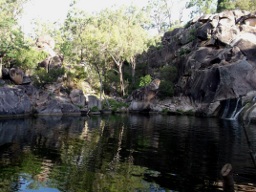
|
|
Back up the hill, and the clouds were even more spectacular; some showed
a wide range of black and white, others played hide-and-seek with the sun.
I went back to the hotel, met Marie, took a shower and oiled my shoulder,
and we went to dinner. It was a typical large pub meal; I had smoked pork
chops, which were huge and very tasty and came with a mountain of veggies.
We had a nice bottle of wine with it, and paid for our rooms at the same
time. We sat and had a leisurely meal, then strolled down the road to the
Observatory (slogan: "Our business is looking up"). In the fading glow of
sunset, a small crescent moon and a bright Venus shone in the western
sky.
|
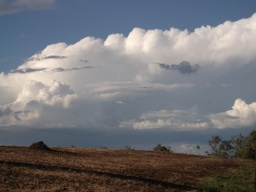
|
|
Despite what the astronomer James had said to Marie over the phone that there
might be no show if he had no bookings, eighteen people turned up, and he
turned away another party of five who arrived a bit late.
We had a very fine show. James rated viewing conditions (on a
scale of 1 to 10) as between 6 and 7: clear, but the atmosphere a bit
turbulent after the storms. We got, in order, Venus (extremely bright, so
that the gibbous phase was not easy to see); Jupiter, with the Galilean
moons and a background star, and the cloud bands clearly visible;
the Orion nebula, a huge swirling cloud illuminated by a trapezium of
bright stars; Rigel, the top star of Orion from our perspective, a very
bright blue star with a faint companion which I could see but some of the
others couldn't; an open star cluster looking like a sheet of velvet with
bright jewels sewn on, undulating in the breeze; a globular cluster;
the Tarantula Nebula in the Large Magellannic Cloud, whose appearance was
very odd but where I couldn't really make out the shape of the spider;
Jupiter again, so we could verify that the moons had moved slightly;
and then the edge-on Silver Coin galaxy.
|
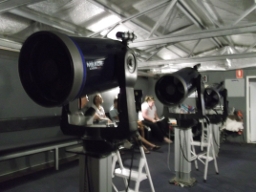
|
And then home to bed where, after jukebox music for a while, the pub fell
silent and we slept.
Wednesday 28 December
|
I woke before breakfast and went out for a little walk around the village.
When I came back, the sun through holes in the window shade was making an
amazing picture on the window glass, which I snapped.
Marie and I got to the Trading Post for breakfast at 8, but were not the
first. I had corn fritters with bacon and fried tomato, with coffee, and
we shared an apple juice, which despite the brand name "Hunter valley"
was made from imported juice; this seems to be a common problem here.
|
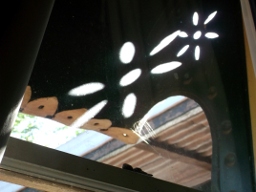
|
|
After breakfast we did a little souvenir shopping in the shop, then went
back, brushed our teeth, loaded our stuff into the car, and set off for
the Bunyas.
The road went for some way through scrubby sandy country, but eventually
started to climb, and after a while the scrub gave way to rain forest with
giant bunya trees. We turned onto the road along the range, stopping to
admire the views south over the Darling Downs, and eventually turned in to
the camping place.
|
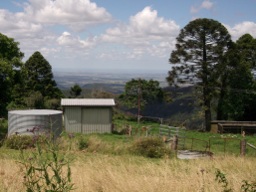
|
John and Jenny were due in an hour and a quarter, but Marie was pretty sure
they would be late, so we went for a walk in the forest first.
|
We followed
the trail for Paradise Falls, After a bit less than 3 kilometres, Marie got
bored waiting for the falls to appear and decided to turn back; I went on.
I passed the Paradise carpark with a sign saying 3.1km back one way, and
4.4 the other. Of course I went on. The path went down the creek, passing
two falls (Paradise and Little Falls) with some water coming over, and
some nice pools in the creek.
The giant trees in the forest are largely bunyas and figs, with a smattering
of other types (red cedar, etc.) The bottom storey is small ferns with the
occasional yam or palm lily. There is very little between, except for young
trees struggling up to the light, and a few things like gympie-gympie, the
stinging tree. There were strangler figs in every stage of development, from
one where the roots were still some way from the ground, to others which were
just fig trees with no sign that there had ever been anything else.
|
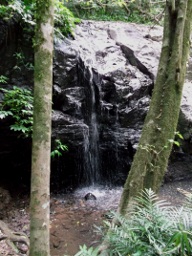
|
The forest was full of birdsong, with whipbirds, kookaburras, and once the
sound of one or more catbirds dominating. But the only birds that showed
themselves were unidentified little brown birds flitting among the ferns
and fallen logs.
About half a kilometre from the carpark turn I came to Paradise Falls, where
quite a long descent was needed to take me to the bottom of the falls. Then
down the creek, past Little Falls, at which point the path started ascending
the side of the valley.
|
I came to the place where the stream plunges over
the edge and down to the lowlands (Big Falls) but the path goes nowhere near
the falls, only to a viewpoint on the way to the lookout over the South
Burnett. I forewent the viewpoint, having had a good panoramic view when
I first came out of the forest.
Through more rainforest, the trail goes through a bit of drier sclerophyll
forest of eucalypt and grass trees, where the understorey was thick grass,
broad-leaved plants and wildflowers. Then back into the rainforest, as
sudden as going through the door. I came to the strangler fig so large that
the path goes through the middle of it; a family was having a photo
opportunity but let me past.
|
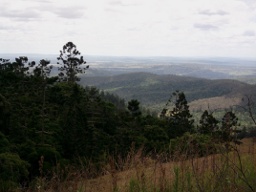
|
Back to the picnic area less than 20 minutes late.
Marie had just got there; there was no sign of anyone else, so I sat on a
seat to wait. Suddenly from nowhere Gillian with the boys (Bailey and Cooper)
popped up and greeted me. She had arrived some time before and had found a
parking space by the picnic tables, and had also bagged a table. We went down
there and got out our small contribution to the feast. Bailey started
assembling a portable gas cooker.
After some time John and Jenny arrived. It hadn't been a disaster on the farm
that had delayed them, but simply a very long wait for the hire car.
Inspection showed that the gas cooker was unusable, since an important piece
of kit, a coupler between the gas cylinder and the cooker, was missing.
Fortunately there was a barbecue nearby; unfortunately it took 20 cent coins,
and we could only rustle up six between us. John started cooking the steaks
and sausages, while Gillian went up to the kiosk to get change. Meanwhile
Bailey, who had brought along his cricket set, wanted a game. After he had hit
a ball between two parked cars, we realised we had to move the stumps to a
more inaccessible position, after which we played happily, managing not to
lose balls in the undergrowth; John pitched in when cooking duties allowed.
|
Finally all was ready and we sat down to eat. Nice steak sandwich, salad
(fresh tomato and cucumber, and potato and seafood salads), followed by
pavlova for Gillian's birthday. Sad to say, Jenny started cutting it up
before the ritual of blowing out the candles, and when the candles were
stuck in the remaining piece and lit, the wind blew them out before Gillian
could. It was delicious (Mango, blueberry and cherry).
Our picnic attracted a kookaburra, a bird with striking purple eyes which
turned out to be a female satin bowerbird, and several cheeky currawongs.
These squabbled in the trees, caught on the wing pieces of meat Marie tried
to throw for the kookaburra, and landed on the table behind our backs and
ate pavlova off our plates.
|
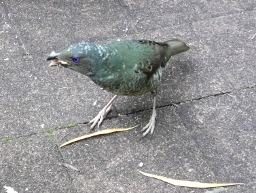
|
|
Afterwards, while the others packed up, I took Bailey for a walk in the forest.
We went as far as the fig tree with the path through it, where I took his photo.
He is even better at posing for the camera than Lex (though he is a few years
older). He decided he wanted to race me back. I took on the challenge,
caught him by the entrance to the forest, and was ahead when we got back to
the picnic area. There's life in me yet!
John and Jenny had meant to leave at 3 to get back for the milking, but it
was after 3:30 before we finished our goodbyes and got underway. Jenny
drove; John's feet are very badly swollen at the moment. We followed
Gillian's car to Kingaroy in case of mishaps, and then set out for Gympie,
passing through towns like Goomeri and Kilkivan where they might retire
if and when they can sell the farm. (Helen wants them to move back to the
Darling Downs, but understandably they are not keen.) We turned off the
main road and took the scenic route back through the beautiful valley where
the village of Widgee lies. All the country is looking at its best at the
moment.
|
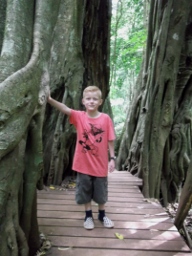
|
|
We stopped at the house; I went out onto the back verandah and immediately
noticed the change: the Moreton Bay fig tree has gone. Apparently it was
killed by the floods and they had to chop it down. Jenny made me a cup of
coffee and gave me a piece of fruit cake and a copy of the map of the
Cooloola Trail that Rob made: 85km, with a suggestion to walk it in five
days. There is a route description, but much of the leaflet is about how
to deal with floods, fires, etc. The maps and profile are very well done.
Rob was bringing in the cows, having arrived back from a day of checking
campers' permits only just before we got there. John and Jenny set out to
milk, while Rob and I had a long chat, finding ourselves very much in
agreement about what is wrong with the world and how it should be put
right.
Finally the milking was finished; quite late we sat down to a light supper
of toasted ham and cheese sandwich, followed by a glass of the most
extraordinarily delicious chocolate port made in Goomeri. And so to bed.
|
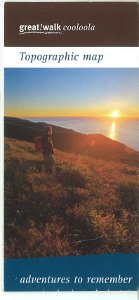
|
Thursday 29 December
Today is to be an easy day, no adventures planned.
I got up a bit after 7 and took a shower; milking was already going on,
John and Rob doing it, so Jenny made me a cup of coffee and we waited
until the others came in. Breakfast didn't happen until about 10, and
consisted of chops, sausages, bacon and eggs: my first fried breakfast
for a very long time!
After breakfast I processed the very large number of photos from yesterday,
and then wrote up my diary.
We had a lazy morning while Jenny cooked goulash for lunch. Just as she
served it up, the vet came to look at a sick calf, who had come down with
a third bout of pneumonia which didn't seem to respond to the antibiotic.
The vet left a one-shot antibiotic which might do the trick. So it was a
sequential, but very tasty, lunch.
|
I went off for a walk after this late lunch. I headed down to the lagoon,
and went as far as the fence that blocks the way. Then I retraced my steps
and went on along the track to the river, and back up the lane, re-gravelled
after severe damage from the floods.
The lagoon was in very good shape: no bank collapse, only a couple of fallen
trees in the water. It was swarming with ducks, perhaps more than 50. I
also saw lots of cattle egrets on Peter Beattie's Herefords, and a few
swamphens and crested pigeons. The river was in slightly worse case, with
one bank cave-in forcing me up to the top. As well as ducks, I saw a heron
and several cormorants there, as well as twittering swallows swooping over
the water. On the way there I had passed several butcherbirds and a small
tree with four willy wagtails.
Coming back up the lane, there were several ibises. Most of the cows just
watched me go by, but the last four were a bit skittish and started to run
away up the lane. I went very quietly and made friends with the calmest of
the four, and then they let me go past.
|
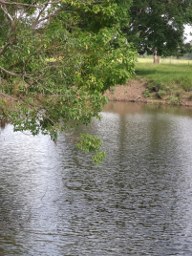
|
There was a big grey cloud in the west, but no sign of rain yet. John was
just about to set off after the cows, so after a chat, I left him to it and
went in. Rob was fixing the aerial, and once it was straight I watched the
television news before typing more of my diary.
Afterwards, we vegetated in front of the television for a while, eating
leftover goulash recycled as thick soup, and watching highlights from an
ABC documentary programme. There were two very contrasting pieces. The
first explained how beef farmers had been wrong-footed by the animal
welfare people's use of social media over the Indonesian abbatoir affair
(which had the effect of destroying many people's livelihood and whole
communities), and how they are learning to fight back. The second was a
genuine and shocking account of cruelty and neglect on a Northern Territory
cattle station owned by the Charles Darwin University, over which nobody
was prosecuted or held to account. The vice-chancellor managed to come up
smelling of roses, but it seemed clear that the breakdown had been caused
by a facility which was supposed to be for training and research having been
told by someone in the university administration that they had to make
money, so they overstocked and then found themselves unable to sell their
cattle.
On that depressing note I went to bed.
Friday 30 December
I woke early and lay listening to the dawn chorus. Some of the birdsong I
recognised (magpie, peewee, butcherbird, willy wagtail, kookaburra), but
some was not familiar to me.
|
I made myself cereal and coffee. When I'd finished it, Jenny came over to
say that Gabriel was about to give birth, so I wandered down to watch.
I was very struck by the fact that Gabriel, a fourth-time mother, couldn't
settle to anything; she would lie down, get up, walk a bit, eat some grass,
lie down again, and so on. But as soon as the calf plopped out, she knew
exactly what to do; she licked it until it was almost ready to get up.
I didn't wait for it to stagger to its feet, but came back to the house.
The calf was a heifer, so they asked me to name it. I thought I should
follow the angelic theme, so suggested Raphael; Jenny added an e at the end
to make the name sound more feminine.
|
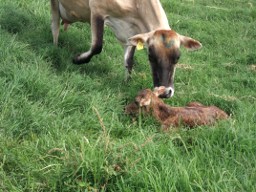
|
The day's excursion was to Tin Can Bay. We set off and drove through Gympie
and out along the road to Tin Can Bay and Rainbow Beach. It was not the most
attractive drive; fairly soon we were in an extensive forestry plantation
made up of identikit pines, and after that a stretch of coastal scrubland
before we actually arrived.
|
In the pine forest there were striking yellow flowers by the road, and we
saw a pregnant brumby mare.
The plan was to get fish for lunch. We walked around the car park and down
the road until we found a wholesale and retail fish works. But the only cooked
fish they had was prawns. The woman in the shop directed us 50 metres down
the road. More than 500 metres later, we did indeed come to a fish and chip
shop, where we each got a pack of fish, chips, and salad. Three of us had
whiting, Rob chose snapper. We went across the road to where there was a
table under a shelter.
It was a substantial and tasty plateful of food, with a large quantity of
chips. The wind by this time was very strong, and it was all we could do to
stop our lunches, cutlery and paper napkins from blowing away.
|
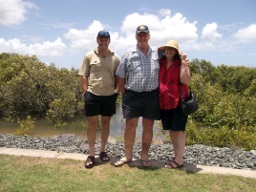
|
|
There were a lot of gulls around, standing eyeing us meaningfully. After a
while, someone weakened and threw them a chip. At once, the number of gulls
quadrupled and the squabbling began. Once we left, they were under the table,
noisily cleaning up what we had dropped.
Jenny's foot was giving her a bit of trouble, so we walked back along the
beach, which involved paddling at some points (the tide was very high, though
it was going out). We found oyster shells, mangrove seeds, and various other
interesting things on the beach. It was very nice to feel the warm water
on my feet!
At the end of the beach, we found a tap to rinse the sand off our feet, and
then got back in the car and drove home, stopping at the fish shop for some
prawns for dinner.
|
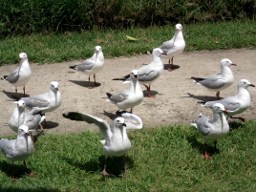
|
|
At the end of the beach, we found a tap to rinse the sand off our feet, and
then got back in the car and drove home, stopping at the fish shop for some
prawns for dinner.
A couple of stops in Gympie, at the bottle shop where Craig works (he was out
the back going to the bathroom), and then at the supermarket (where
inevitably a couple of acquaintances were found and a lot of time was spent
talking). As commissioned, I got tim tams and violet crumble there. Then we
drove home, had a cup of coffee, and John and Rob went off to do the milking.
Jenny made intention movements to do the dishes, so I managed to stop her
(with great reluctance; with the best intentions, she seemed to think that
I wouldn't be capable of washing and drying dishes). Instead of sitting
resting her foot, she went off to help with the milking. So I transferred my
photos and wrote my diary for a while.
|
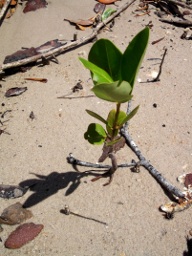
|
After milking we sat down and ate the prawns and bugs, with wholemeal bread
and butter and a glass of sweet white wine. Then we sat around talking until
bedtime.
Saturday 31 December
I woke up and looked out the window to see a beautiful clear morning.
When I had showered and got dressed, I found the relief milkers were
there having finished their job, and the news was that Gabriel was down
with milk fever. This is caused by calcium deficiency when a cow's milk
production goes into overdrive after the calf is born.
By then the clarity of the morning was gone and the sky was overcast.
John and I went down to see what we could do. He had explained the "old
aboriginal method" for getting a cow up, which was told him by an Afghani
vet. THis requires two people; one goes to the front end, the other the back.
The one at the front gains the cow's trust, and then suddenly and as loudly
as possible yells into its ear. The cow is startled into trying to get up.
Cows get up back end first, so with the person at the back pulling on the
tail, she is got to her feet.
We tried it once, and it almost worked. So John drenched her with a mixture
of astonishing and vile-smelling stuff, some of which was kelp and some of
which may have been antifreeze, and tipped two buckets of water down her
throat, and then we tried again. This time, she got to her feet, and
Raphaele went over to have its somewhat delayed feed.
I came back in and got on with trying to find times of buses to Brisbane.
It turns out that the first bus leaves Gympie at 3.05 and the second at
11; since my plane is at 13:40, the latter is far too late, so it will be
up early. But the Matilda services is as close to Lagoon Pocket as Gympie,
and since the bus spends over half an hour there, I can make a slightly
later start. With a bit of difficulty I managed to make a reservation
and print out the ticket.
Apart from that we didn't do much but sit and talk. Jenny showed me some of
Bailey's pictures on the fridge. One of this was on a prepared sheet with
some spiel about God's good gift, and the children were instructed to draw
a picture of one of God's gifts that they particularly like; Bailey had
done a self-portrait. Carrying on the egotistical theme, John liked my story
about how I got the Drapers' Prize.
Jenny cooked a very nice meat loaf for lunch, which we had with potatoes
and Marie's zucchinis. After lunch Rob went off ploughing the bottom
paddock, while we sat round talking. Just before milking, we found that
Gabriel was down again. John and one of the relief milkers managed to get
her up, but going into the yard she tripped over a concrete lintel and fell
right in the gateway. This would have been a problem, since the rest of the
herd would have to pass her to get to the milking bails, so we tried again
to get her up; she lurched to the side of the yard and collapsed under a
tree. A shower passed by and we had a few spots.
As the cows come past, being naturally curious, they can't resist taking
a close look, and sometimes a bit of roughing up. So I stood by her to keep
the others from getting too close. Standing in the yard, with the hills a
deep blue after the shower, gum trees all around, and an ibis sitting on the
yard fence keeping an eye on proceedings, I felt at peace.
John gave her more calcium, then phoned the vet about some other drug (not
sure what it was) and was given the go-ahead to give her some. At the tail
end of milking, they managed to get her up and into a pen where she could
be with her calf.
We watched the news and the Edinburgh Tattoo, and I wrote my diary while
Jenny wrote up the day's events cow-wise into her herd books; we had
leftover meat loaf for our dinner. The Tattoo, filmed on a rainy Edinburgh
night, gained visual impact from the reflections of the lights in the wet
road. But before it was over, both John and Jenny had nodded off. So we
agreed not to stay up to see the New Year in.
I went to bed and lay for a while wondering what 2012 will bring for us.
John goes into hospital for a hernia operation on the 9th; I hope it does
the job. He and Jenny both walk very slowly now; John has lymphoedema which
makes his feet swell, and Jenny had an undiagnosed broken bone in her foot
which is now inoperable. Rob is applying for a job of wetlands coordinator
for the Mary and Burnett river systems; this would be a big step up for him,
though he does seem to have exactly the experience required. Applications
close on the 6th. John and Jenny are hoping that in a year or two the
economic climate will have improved to the extent that they can sell the
farm and herd, and retire with a few cows and a small parcel of land somewhere.
Unfortunately the dairy industry in Queensland seems to be in terminal decline,
due to factors outside their control, so it is unlikely that they can sell
the place as a going concern; they will have to break the farm into blocks
to sell separately (the two near the road could go to hobby farmers, and the
others to their neighbours), and sell the herd to a dairy farm elsewhere.
With these thoughts I fell asleep.
Sunday 1 January
I woke quite early and got up. The relief milkers were on again, and so
we had a leisurely start to the day, and scrambled egg with tomato and
shalott for breakfast.
|
John drove into town to pick Craig up, and I went along for the ride.
After collecting him from his place, we stopped at an arcade commemorating
wars that Gympie residents have been involved in, from the Maori wars to
Afghanistan, with impressive tiled murals. We also stopped to get a
watermelon from a roadside vendor. John has discovered where seedless melons
come from (it seems an impossibility, at first). Apparently they are regular
melon plants which are injected with hormone to stop them producing seeds.
Makes you very disinclined to eat seedless melons! It seems that the
exploding melons in China that were widely reported this (northern) summer
were caused by an overdose of the hormone.
|
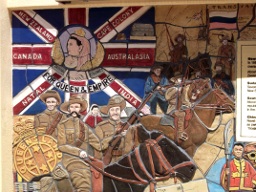
|
|
At home Jenny was cooking the Sunday lunch, roast leg of pork. Peter Beattie
from next door was also there (his father died a few years ago), so six of
us sat down to the delicious dinner, after Rob had come back from ploughing.
We whiled away a leisurely afternoon. I showed Craig some of Neill's artwork
on the computer. He was particularly impressed to find that Neill was
responsible for the A-Z of Awesomeness, which is apparently very popular with
Craig's circle.
Peter went home, the milkers showed up, and we had toasted ham and cheese
sandwiches for our tea. Then we watched the television news. An early start
tomorrow since we are going on a fairly long drive and John and Jenny have
to milk before we set off.
|
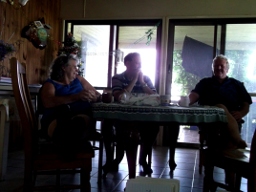
|
There was a huge green frog in the toilet; but it wasn't doing any harm, so
I left it there.
Monday 2 January
I woke early and totted up my kilometres walked for 2011. My lowest total
almost since records began. Bad news.
I got up and had a shower. Rob (whose birthday is today) removed the frog
from the toilet and put it into the garden. Then I caught up with diaries
and things. Jenny came back from milking to make pancake batter and let it
stand.
We had pancakes for breakfast, with a choice of maple or vanilla syrup or
honey. Then we were off on a jaunt. (Rob didn't come with us; it is the last
day of his holiday, and he needs to get his CV for the job application
finished.) As we left along Lagoon Pocket Road we saw a wedge-tailed eagle.
We drove down the Mary Valley highway and across the Traveston Crossing Road
to the Bruce Highway, where it took us a while to get onto the road. We soon
turned off it and took the road through Cooran to Lake Cootharaba on the edge
of the National Park. We drove first to Elanda Point where it seemed that
they might have charged us to stop by the lake, so we turned back towards
Boreen Point, which Rob had recommended to us.
The lake was very shallow, choppy and brown: apart from a narrow boat channel
it is possible to wade across it (though it covers a large area). There was
a small food shop right opposite the picnic spot on the lakeside, so we went
and bought fish and chips and drinks, though it was early for lunch. (None
of us felt like looking for food in Noosa.) The shop owner was quite chatty.
Across the road was a dead tree with a strange growth at the top. He told us
that it is called moonlight cactus because it only flowers at night, that it
is poisonous to trees and would kill all the trees if it spread, and that
the last time it was pruned they took off 40kg of plant matter.
We sat at a table on the lake shore, looking past a twisted and gnarled
paperbark and a she-oak out to the lake, where various boaters with varying
degrees of expertise were sailing to and fro. We ate the fish and chips, which
was beautifully cooked and very tasty, though it was probably more than we
needed, watching the misadventures of various sailing boats.
Then we set off for Noosa, intending to walk in the National Park.
|
Noosa is completely transformed since I used to go there in the 1960s. It is
a huge holiday resort now, and the traffic in the centre is virtually at a
standstill. There were crowds of people on Noosa beach, but not a single
vacant space in the car park. So we gave up and left.
I thought my chance for a walk in the National Park was gone, but we saw a
turn-off to Sunshine Beach and took that. This resort was much less crowded,
and it borders the National Park on the south side. John and Jenny told me to
go on while they pottered. So I walked down the beach and up a very steep
hill, with 206 steps as well as an inclined sequence of sleepers and some
ascending path, shaded by banksia, pandanus, and she-oak.
|
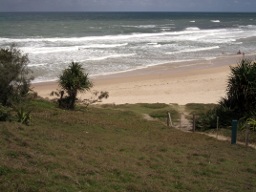
|
|
The view from the top was magnificent; the beach, golden-white and almost
deserted, stretched all the way to Mt Coolum in the distance. I carried on
and came to a point where the path descended to Alexandra Bay. I hadn't
known that this is a nudist beach; but I observed that it was mostly the
old people who took their clothes off, while the young kept covered up.
There were also many surfers on boards off the point, and several photographers
with huge lenses on the beach focussing on them.
|
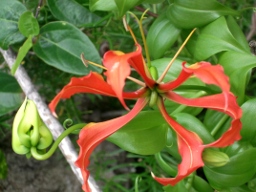
|
|
I walked down to the end of the beach, seeing some colours in the sand cliffs
at the back of the beach, and crab holes with their tell-tale balls of sand.
A small shower came on, nothing more than a few spits of rain. So I turned
back and returned the way I came to the car, where John and Jenny were
waiting, and had sorted out our route on the map.
|
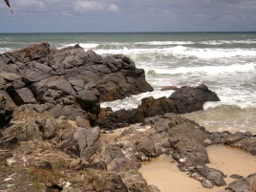
|
|
We drove down the coast road to Coolum. Though it is really just a single
beach, it has been divided up and developed, and the different stretches
have various silly names. Sunshine beach has always been called that, but
the next beach is now Sunrise beach.
At Coolum we turned inland, crossed the Sunshine Coast motorway, and drove
through abandoned canefields to Yandina and the ginger fctory. The sugar
mill at Nambour has closed; I asked what had happened to Sandy the Cane Train
but they didn't know.
|
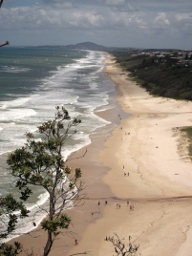
|
|
We stopped at the ginger factory. Time was short, so we had cold drinks,
admired some of the flowering ginger, went to a few shops, had ice creams
(I had ginger and mango, though I only resisted ginger and macadamia with
some difficulty.) We picked some tourist leaflets. One of them, which was
so appalling as to be funny, read in big letters, "FLOOD: HORROR AND TRAGEDY",
and in smaller letters below. "An ideal gift at $49.95". There were others,
of cruises on the Noosa river and hiking around and up the Glasshouse
Mountains, that looked more interesting.
Then we got in the car and set off home.
We went through some really lovely country, through Belli Park and Carters
Ridge and back to the Mary Valley Highway. The hills were dark green where
the bush remained, and bright green where it had been cleared; one very
attractive farm had a herd of Jerseys and John and Jenny decided it was
a colleague of theirs who moved fairly recently.
|
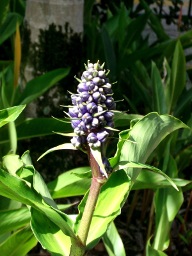
|
Then we were travelling through the land reprieved from the Traveston Crossing
Dam. It was looking a bit down at heels. The reason is that after the State
government bought up all the properties, they did nothing to them (or perhaps
demolished some buildings), and now are offering them back to the original
owners (if they can be traced) at the price originally paid. On one large
dairy farm, the farmhouse has been left to go to ruin, the new milking bails,
yards and sheds were bulldozed. Now the paddocks are let to another farmer
but it may never be a farm again.
Back home, John and Rob started milking, and Jenny and I sat in the comfortable
chairs and had a long chat about families, the way things are not what they
used to be, and so on. Then she got up to relieve Rob, whose birthday it is
today, and I transferred and edited my photos and wrote up my diary.
There was a sick calf, Morticia by name, with a temperature of 38 degrees,
who needed treatment. This delayed tea a bit. Finally we sat down to ham
salad, followed by Rob's birthday cake from the ginger factory, with five
candles in it.
And so to bed.
Tuesday 3 January
John's current favourite joke concerns a time, many years ago, when a water
monster was terrorising people who lived near the river Thames. Nobody could
do anything about it, so finally they called in St George, who came and slew
the monster. Unfortunately, he then had some trouble disposing of the carcase.
Eventually he gave it to a local butcher, who turned it into sausages. When
Charles Dickens came to write up the story, he began his account:
"It was the beast of Thames, it was the wurst of Thames."
At breakfast, Jenny offered me the use of the washing machine. I didn't
shove everything in: knickers and socks are the most important at the
moment. Before we were ready to go, the wash was finished, and I hung them
out to dry on the back verandah.
The telephone brought the news that John's and Jenny's friend Noel, a
stalwart of the dairy industry in Gympie, has lost his battle with cancer.
His wife Barbara asked John to give the eulogy at the funeral.
|
After breakfast of scrambled eggs with the last of the bacon, we set off on
the final excursion. This was to Dickabram Bridge, one of two remaining
bridges in Australia built as road and rail bridges. (Jenny thought it was
one of three.)
We drove through town, and up the Bruce Highway for some distance until we
turned off through a tiny village with not much more than a pub and cafe.
We came over the bridge, drove over it carefully, and parked in the picnic
area on the other side. The surface is made of wooden sleepers, and Jenny's
theory of how the bridge got its name is the sound cars make driving over it:
"dickabram-dickabram-dickabram". (In fairness I should say that there are
alternative theories; one holds that it is an aboriginal word, and the other
that it is named after the first settlers, Dick and Abraham.)
|
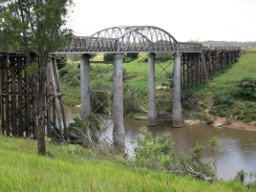
|
|
The signboard in the picnic area was very informative, giving details such
as the fact that a workman took a barrowload of concrete to tip into one of
the bridge pillars, and was never seen again: it is presumed that he and his
load fell in, and were covered up by concrete tipped by the other workers
who hadn't noticed. It is claimed that fishermen at night still hear ghostly
moans and tapping sounds (though of course there are much simpler explanations
for these). The bridge is high enough that only one flood has ever overtopped
it, and another lapped at the planks. It was a long way down to the
now-peaceful river, and the scenery around was lovely.
A cairn gave a list of some family names in the neighbourhood when the bridge
was built, and marked those with descendants still living in the district,
and those whose families still own the same properties: surprisingly many
in both categories.
|
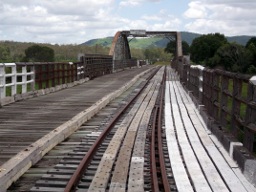
|
Of course I had to walk over the bridge, though John and Jenny decided to
stay in the car. There is a little walkway beside the railway line, or one
could walk between the tracks (no trains have run for many years). On the
other side, there was a small umbrella in the paddock, and a man sitting in
a car. I fell into conversation with him. He was an artist who was drawing
a picture of the bridge. When the sun shone, the white paper was too bright
and dazzled him, so he would go and sit in the car, returning to his seat
under the umbrella when a cloud came over. He was English, born in Surrey,
but had lived in Australia for many years. One thing he and friends had
done was to set up a website called "giveit", where people who had been
flooded out (for example) could post a list of exactly what they needed,
and people who could help out could then target their aid very precisely.
He showed me a book about the history of the bridge, produced for its 125th
anniversary last year, which I wanted to try to get hold of to send to John and
Jenny as a thank-you present. (In fact it turned out to be unavailable.)
I left him and walked back over the bridge and got into the car, and we set
off for home. This was much drier and harder country than the rich river
valleys, but the roads were in pretty good shape. The only problem came
when John had a senior moment and turned the wrong way on the Gympie to
Kilkivan road. We went again along the road through the beautiful Widgee
valley.
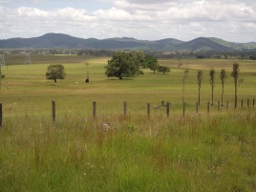 |
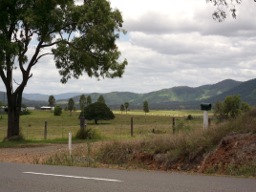 |
We drove to a new shopping centre (few shops so far open) on the south side
of town, for bread, meat, and wine. One of the few shops open is a bakery
and cafe run by Dick Schroeder, the man who runs the Cooloola Milk factory
where John's milk goes - he deals only with Jersey herds. After we had
shopped, we decided to save the steaks until Rob is home in the evening,
which left us with nothing for dinner. So we agreed to try out the cafe.
(Today was its opening day.) Of course, I chose to have a cappuccino, and
very rich it was! John ordered pie and mushy peas, but sad to say they
didn't have mushy peas. But the salads were very good.
Dick came out for a chat at one point. John says that part of the problem is
that he feels the need to have several fingers in each of his pies: although
he has a very good baker, he can't resist telling the baker exactly how to
do things.
Then home, after a stop at the vet to stock up on some medicines that were
running low.
Back home, we had cold watermelon from the fridge, then got the vacuum
cleaner on an extension lead, a bucket of soapy water, a squeegee, and a
couple of rags (John's old shorts) to clean the hire car prior to taking it
back. There is a peewee living in the jacaranda tree, who had crapped all
over the car, including the wing mirrors (on which it perches). I wrote up
my diary while they were out. I think I will resist the temptation to try
ordering a book on the computer here.
I walked out the front of the house, and heard amazing screams from a tall
gum tree across the road. There were two large birds perched right near the
top, brown backs and light underneath, with slightly downcurved beaks; much
too far away to see detail. A quick scan through the bird book left me none
the wiser.
The phone rang, and Barbara left a message, asking John not to make the
eulogy so long that everyone falls asleep.
After an excellent dinner of steak, salad and wine, followed by custard slice,
ice cream and cream, with a shot of "moonshine", I read through Rob's
job application and resume, and gave him a few comments which may be useful
and a few proofreading corrections. Then off to bed.
Wednesday 4 January
It was a busy morning. Morticia died in the night, and Adelaide brought forth
a calf. Its sire was something Bright Lights. I said "Bright lights, big
city", and Jenny said "Paris"; so that is what it will be.
Then the guys came to look at the TV. Rob had called them because he had
fitted a 2-way splitter on the cable from the aerial but couldn't get
anything in his room. They checked the signal and found that, instead of
the 70 decibels it should be getting, the signal was only 25 decibels. So
they installed a new antenna and a booster, and connected up a few cables
and pressed a few buttons on the remote control, and suddenly lots of
channels were coming in loud and clear. Of course the TV was immediately
turned to the cricket, and stayed there for most of the day.
Finally, that out of the way, we had breakfast at about 10:30, bacon and eggs.
I watched the cricket for a bit while I drank my coffee: Ponting and Clarke
were playing very well. Then I went off and packed, having just a little bit
of trouble finding my stock of twenty pound notes and the itinerary for my
trip home, but no trouble at all getting everything – Tim Tams, Violet
Crumble, various combinations of ginger, macadamias, chocolate, etc. –
into my bag. Maybe it's as well that I was forced to travel light on the way
out.
|
After vegetating most of the day, I was called to the table to eat beef and
beer stew for my lunch, and again later to eat watermelon for my tea. After
that I made use of my last chance to walk back along Lagoon Pocket Road.
A flock of magpie geese has camped at the waterhole. They were almost out of
sight up the paddock when I passed, but it was clear that the waterhole was
much influenced by them: no waterlilies, muddy water, no other waterbirds
(though there were a few wood duck and swamphens in the paddock). There were
a few waterlilies in the pool on the other side of the road. I also saw
quite a few pale-headed rosellas.
Back to the house, after I had dried the dishes it was milking time. I went
out to see Paris, the most beautiful little calf I have seen in a long time.
Then I went back in, transferred my last photos, and wrote up some more diary.
|
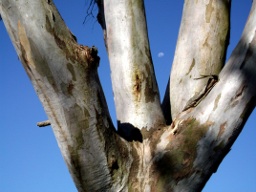
|
Rob came home, and checked out his television, which is not completely
satisfactory; I think some of the stations need to be re-tuned. I went out
to take a last look at the stars. Venus was bright in the west, but a nearly
full moon and some light cloud made the other stars less dramatic than they
should have been.
After milking, we had leftover beef and beer for tea, with a glass of wine and
some very nice Cooloola brie and camembert. Then we swapped photos (I gave
them some family photos, and took some flood photos in return), and some
up-to-date addresses of family members. Then, a little earlier than usual,
we turned in. Rob is intending to get up to see me off, but I said goodbye
just in case he doesn't make it.
Thursday 5 January
I woke up a quarter of an hour before my alarm went off, went to the bathroom
and dressed, and put the kettle on. John came out and made coffee. I walked
out to look for comet Lovejoy. No sign of it, but the stars were blazing out
in a fine display, the Southern Cross and the Pointers clearly visible on
the east side of south.
Jenny and Rob appeared, we said our goodbyes, and set off. There was some
low ground fog on the dark road, but no traffic, even on the Bruce Highway.
At Matilda, Kybong, there was a Greyhound coach sitting in the coach area,
saying Brisbane on the front; it was in total darkness and extremely battered
and bug-spattered. We waited, and eventually the driver showed up, checked
my ticket, and took my bag. John set off, in a senior moment forgetting to
turn on the ute's lights. I hope he didn't get too far before he remembered!
I got on the bus and found it wasn't empty as we had thought. It was far
from full but there were quite a few sleeping bodies on board. I found an
empty seat and took it. The bus left five minutes early.
I had wondered about sitting on the left side and having another look for the
comet, but in fact the road goes more east than south for a spell after
Gympie, and I had a good view of the cross and pointers, though no sign of
a comet. On the left, light was beginning to show on the horizon; the trees
were black silhouettes, and the stars slowly dissolved in to the gathering
light. The last to disappear were two planets (Mars and Saturn?). Cormorants
flew over, little more than silhouettes.
After a while we turned off the highway and took the road into Nambour, a
town which has disused cane train lines in the middle of some of its
streets, though the mill has closed. We pulled up at the bus-rail interchange,
where a train was waiting. Soon it set off, and then so did we.
After Nambour, colour was returning to the world. The trees were no longer
just silhouettes; some of them were covered in blossom. We passed the
Glasshouse Mountains at about sunrise. It would have been nice to report that
the first rays of the sun illuminated the top of Tibrogargan as we passed; but
it wasn't so, as there was a bank of cloud in the east. But by Caboolture it
was full daylight. At Bald Hills we turned off onto a parallel highway.
At Nudgee, we passed a sign to the Australian Catholic University (what's
that?). Soon the tall buildings of the city centre came into sight, and
we ran through suburbs of lovely old houses, industrial estates, the
airport train, racecourses, airport hotels, and the river.
Across Breakfast Creek, we negotiated the concrete spaghetti, and went under
the notorious Normanby Fiveways to run down to Roma Street, arriving five
minutes early.
I had breakfast at Roma Street, reckoning it would be cheaper than the
airport. Then I bought a ticket and caught the train, with almost no wait.
Terribly early at the airport, I went to the bathroom and cleaned myself
up a bit, then found a chair and sat to wait three hours until I could check
my bag (or until Marie came, if that were sooner). My eyelids closed and I
took a nap.
I'd taken the "in-flight magazine" from my seat pocket on the coach,as it had
three sudoku which I thought would while away the time. I did the hard one
and got it wrong, so I did it again and still got it wrong. Undeterred, when
I felt a bit less sleepy, I did it a third time and succeeded. Then I polished
off the other two, had some coffee, and read for a while until check-in opened
for the Singapore flight, when I went and dumped my bag.
Just as I got back to my seat, Marie arrived. We went and had a coffee in
the viewing lounge, where you can wave to the departing passengers. Marie
was catching the 12:25 train, and wanted me to see her off, which left me
a bit short of time. I wanted to get a wombat for Lyra, but getting through
immigration and security took rather a long time, so I had to grab the first
one I saw, even if it was a bit pricey.
As I got into the departure lounge, the flight was just being called. It
got away on time. I was sitting in the middle, so looked at the movies and
found a couple I wanted to see. Woody Allen's "Midnight in Paris" was a bit
slight, but "Living in the material world", Martin Scorsese's documentary
about George Harrison, was deep and moving, even if a bit long: it went on
for 3 1/2 hours, and had only just finished when we were coming in to land
in Singapore. I didn't know that George Harrison had funded the production
of "Life of Brian" by mortgaging his house – but it was a big house!
I missed the beginning of it because of some technical fault,
and only by fiddling with the controls did I manage to make it behave itself.
The woman next to me couldn't get hers to work at all until they did a
"hard reset" on hers and (necessarily) mine too.
Singapore airport was hot and unfriendly. The air-conditioning was off, and I
found it very difficult to stay awake; and when I went down to check on the
departure gate, my boarding card was demanded, and I was firmly told to go
away and come back later.
A little late because of the late arrival of the plane from Melbourne, we
were off. I was in an aisle seat, the two people beside me being rather
klutzy (my neighbour grabbed my screen controller, pumped up the volume,
keeping going because it was having no effect in his headphones), and the
lady has a weak bladder.
I found another documentary I wanted to watch, "Project Nim", about the
project which attempted to take a baby chimp, raise it in a human family,
and teach it sign language. It was quite horrific, for the human participants
as well as the chimp. This is surely not the way to talk to animals.
The tail-mounted camera on the plane showed a gibbous moon just above the
western horizon, never getting any lower.
I got to sleep after dinner, and managed to doze until almost breakfast.
Friday 6 January
The moon was in the same place in the sky at breakfast time, and remained
there until we changed course for the landing run. The smudge of lights
that was London was visible from the other side of the Channel. I looked
at them knowing that my home is down there among them. London
does not look like an American city when seen from the air at night: less
light, more ground detail.
The chief steward told us that somebody had been smoking, and this was the
third warning; if they caught the culprit they would hand him/her to the
police on arrival.
All went uneventfully after that: as before, a long wait to get off the plane
and an even longer wait for my bags, but I was out quite smartly and on a
train for home.





























































